Abstract
To reach carbon peak and neutralization, a low-carbon supply chain is a clean practice that turns supply chain management into a green economy. This approach aims to decrease energy consumption and pollution and accomplish sustainable development across the supply chain. The worldwide logistics business has transformed into an intelligent service provider to the adoption of real-time management tactics made possible by the Internet of Things (IoT). The impact of the IoT on China’s logistics industry and its impact on the environment are examined in this article. This study, a new model is proposed for incorporating the most popular carbon regulations to accomplish the above advantages and create a more sustainable supply chain. This work discusses how to implement effective carbon regulating systems to promote sustainable development. Main contribution of this research is considering the impact of carbon regulations on environmental benefits and enhancing regional development levels in a supply chain network design challenge. In addition, judgments on cargo consolidation are used to lessen financial and ecological footprints. This article examines and analyses the development of a low-carbon supply chain from the two aspects of the IoT and environmental responsibility to better support the sustainable growth of a low-carbon supply chain economy and raise people’s standards of living. Research results show that the industrial scale of China’s low-carbon supply chain economy is expected to exceed 300 billion by 2025. At present, there are still economic development barriers, but integrating the IoT technology and environmental responsibility consciousness into economic development, it has the potential to strengthen the development of a low-carbon supply chain and improve the conditions for long-term, sustainable growth.
1 Introduction
In recent years, China has been faced with increasingly serious environmental and resource problems. The emissions of industrial pollutants, especially carbon emissions, have exceeded the carrying capacity of resources and environment, resulting in serious air pollution, acid rain, and continuous fermentation of smog in many cities. Based on the latest statistics released by China, research group Carbon Brief calculated that China’s Carbon emissions totalled 10 billion tons in 2018, up 2.3% from 2017 (when CO2 emissions grew 1.7%). In recent years, the complexity of environmental problems and a series of environmental changes have occurred in the process of enterprise industrialization construction in China. Therefore, how to deal with carbon emissions will be an important problem facing society and enterprises. Meanwhile, with the development of supply chain node enterprises, resource consumption and carbon emission of low-carbon supply chains are becoming increasingly serious. These results are closely related to the carbon dioxide reduction, energy efficiency, and carbon emission of supply chain node enterprises. Figure 1 depicts the research technology roadmap.
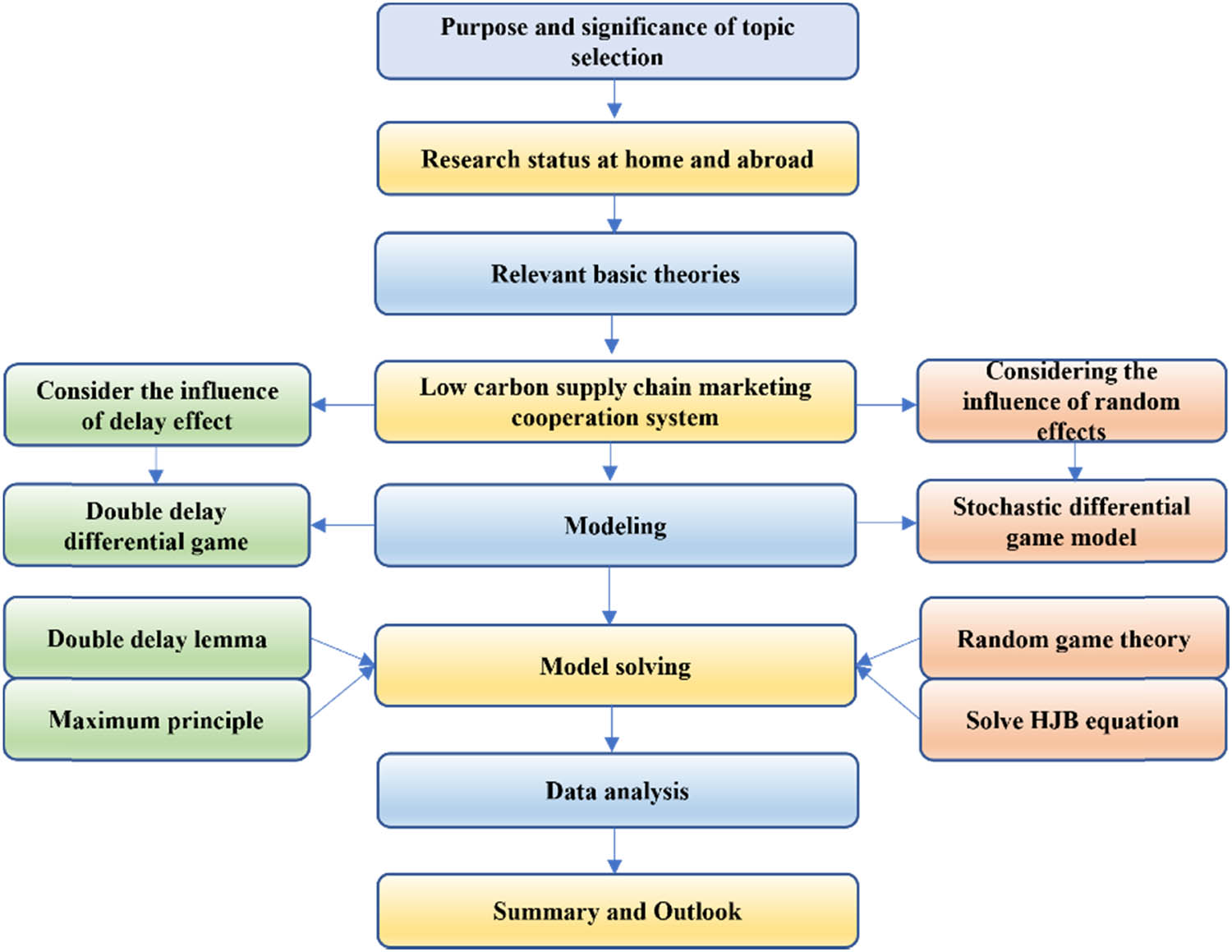
Technological research roadmap.
Energy usage, trash creation, resource depletion, and greenhouse gas emissions are just a few ways SCM impacts a company’s environmental effects. Consequently, SCM may be crucial in helping businesses implement sustainable practices and initiatives, lowering their environmental effect. One definition of sustainability in supply chain management is the capacity to keep standard procedures in place while minimizing environmental negative impacts. The goal of supply chain sustainability is to reduce the effects of environmental concerns such as pollution, deforestation, ozone depletion, and climate change. Reducing emissions of greenhouse gases in all areas that contribute to their formation – including energy production, transportation, industry, and agriculture – is essential to establishing a low-carbon economy. Many articles discuss how we may move away from an economy that produces a lot of carbon and towards one that produces far less. Unpredictable shifts in consumers, suppliers, rivals, and technology are just a few examples of the environmental factors that may affect product chains. The importance of buying and the function’s role in material reduction, recycling, reuse, and replacement is acknowledged in environmental supply chain management. Consequently, a low-carbon economy is defined as an economic system that engages in various practices that produce less greenhouse gas emissions when contrasted with conventional manufacturing methods, thereby mitigating the effects of climate change.
Green supply chain and environmentally responsible supply chain are the inspiration for the LCSC, which seeks to lessen the impact of supply chain management on the environment by cutting down on energy usage and carbon dioxide emissions. LCSCs aim to increase energy efficiency while decreasing carbon dioxide emissions, unlike green supply chains. Also, the LCSC is an outgrowth of the green supply chain that seeks to draw attention to how supply chain management practices may assist businesses in lowering their carbon footprints. This article’s concept of LCSC, drawing from the definitions above, emphasizes the following: lowering carbon emissions in logistics management, coordinating and innovating in sustainable management, identifying and addressing implementation drivers and barriers, and overseeing and tracking carbon emission pathways throughout the supply chain. As a whole, LCSC is based on the idea that businesses should rethink their supply chains, focusing on low-carbon strategies to restructure them to comply with carbon emission regulations and remain competitive in the market. This article primarily presented a life cycle assessment to examine the product life cycle – this method for determining the supply chain’s carbon impact. In addition, it is a useful tool for pinpointing areas with high carbon emissions and guiding managers towards low-carbon choices. The LCSC was, therefore, encouraged to grow via carbon accounting. Carbon reduction tools have also been found to be useful in this sector in the last few years. For instance, businesses are turning to alternative fuels like biomass energy to lessen the environmental impact of manufacturing and transportation. Businesses may mitigate their environmental impact using carbon capture, absorption, and storage systems. As a bonus, carbon certification helps the upstream and downstream parts of the supply chain cut emissions. Based on this, the carbon labelling system encourages businesses to lower their carbon footprint by swaying customers to buy low-carbon products.
Market rivalry has expanded from being primarily between individual businesses to include competition across whole supply chains due to scientific and technological advancements and the on-going growth of the economy and society. Also, the only method to promote a low-carbon economy is to create low-carbon supply chain (LCSC) management. At the same time, rivalry among supply chain channel architectures has heated up in response to the escalating global economic competitiveness. Consequently, choosing a suitable collaboration mechanism to reduce rivalry across supply chains is paramount. Green goods are in high demand because people are becoming more conscious of the need to safeguard the environment. Retailers and other downstream businesses are incentivized to support green supply chains since doing so helps them reach greater social and environmental objectives. This motivates businesses farther upstream to increase their production of environmentally friendly goods. Companies are now competing not just on pricing but also on how well they can preserve the environment from the effects of carbon emissions.
Customers are prepared to pay a higher price for low-carbon goods (LCPs) in a society where numerous groups prioritize reducing emissions and protecting the environment. As a result, suppliers face more intricate considerations about supply chain operations when the market structure changes from one supply chain to numerous. Carbon emission reduction (CER) is an on-going goal for suppliers to satisfy legislative mandates and ease market pressure. They have a two-pronged strategy for LCPs and advertising. One is that producers do CER right from the start by using cutting-edge machinery, sewage treatment, and other innovations in LCP production.
This research shows a strong relationship between SCM methods and the UN Sustainable Development Goals. Further, it highlights SCM’s significant role in addressing sustainability challenges worldwide. As this area of research evolves, it is crucial to explore new topics, enhance methodologies, and promote international collaboration to progress responsible production and consumption as well as sustainability. If academics, practitioners, and lawmakers are serious about promoting GSCM and its positive effects on sustainable development, this study is a great place to begin. The intellectual structure of the field is mapped out in this research using scientific mapping approaches. This mapping exercise will uncover the links between different study disciplines, the historical evolution of research topics, and potential future routes for research. Not only will this research contribute to the academic literature, but it will also help practitioners and politicians move the mapping of GSCM to SDGs forward.
As the supply chain’s resource and energy usage continue to increase, environmental pollution and ecological destruction, environmental protection, governance, and carbon emission reduction will face increasing pressure. Due to different industries, different industries within the industry, and within the industry, there will be great differences in the energy demand structure of the supply chain, the pattern of resource allocation, the production process, and the resource attributes of the supply chain (Alkawsi & Baashar, 2020; Cheryl et al., 2021). In recent years, many well-known international manufacturing enterprises have achieved good environmental and social benefits through low-carbon supply chain management. In the Industrial Low-Carbon Development Plan (2016–2020), low-carbon manufacturing Engineering Implementation Guide (2016–2020), Made in China 2025, China manufacturing low-carbon supply chain development reports that the significance of low-carbon supply chain research has also been highlighted in 2018. Therefore, under the above research background, this essay starts from the perspective of resource attributes of low-carbon supply chain and draws lessons from the research results of low-carbon supply chains at home and abroad (Ghosh et al., 2020). From the perspective of flexible resource and environmental attributes, the focus of the research is on flexible resource allocation in low-carbon supply chains, and multi-attribute, granular computing, cloud model, artificial intelligence (AI) algorithm, hybrid neural network, and other theories and methods are applied. The construction of a flexible resource allocation model in a low-carbon supply chain and the parameters design of flexible resource allocation are the subjects of creative theoretical research, the design of a hybrid algorithm based on the cloud model and its robustness verification, in order to get useful conclusions to guide the actual operation of low-carbon supply chain in China’s manufacturing industry. This article significantly enhances the low-carbon performance of flexible resource allocation in low-carbon supply chain and accomplishes the efficient allocation of flexible resources in low-carbon supply chain from the perspective of resource characteristics (Lin et al., 2021; Wang et al., 2021).
Adsorption, chemical looping, gas hydration, and membrane gas separation are some of the methods that are now in use. However, most carbon capture and storage facilities are for processing natural gas, and as of 2022, CCS only captures a thousandth of the world’s CO2 emissions. Currently, power plants mostly employ post-combustion carbon capture, whereas industrial operations primarily use pre-combustion carbon capture, and oxyfuel combustion systems are the third kind. The method of post-combustion carbon capture involves removing CO₂ from the combustion process’s exhaust. The Greenhouse Gas Protocol suggests using the hybrid model technique, the gold carbon calculation standard. Unlike carbon capture, which is often done near the source of emissions like steel production, direct air capture can remove CO2 straight from the air wherever it is present. There are many potential uses for the CO2, or it might be permanently stored in deep geological formations. Due to its operation with just 2% water, the PNNL system is more cost-effective than competing carbon capture systems. This contrasts earlier and comparable technologies, which used up to 70% water. The supply chain management structure diagram is shown Figure 2.
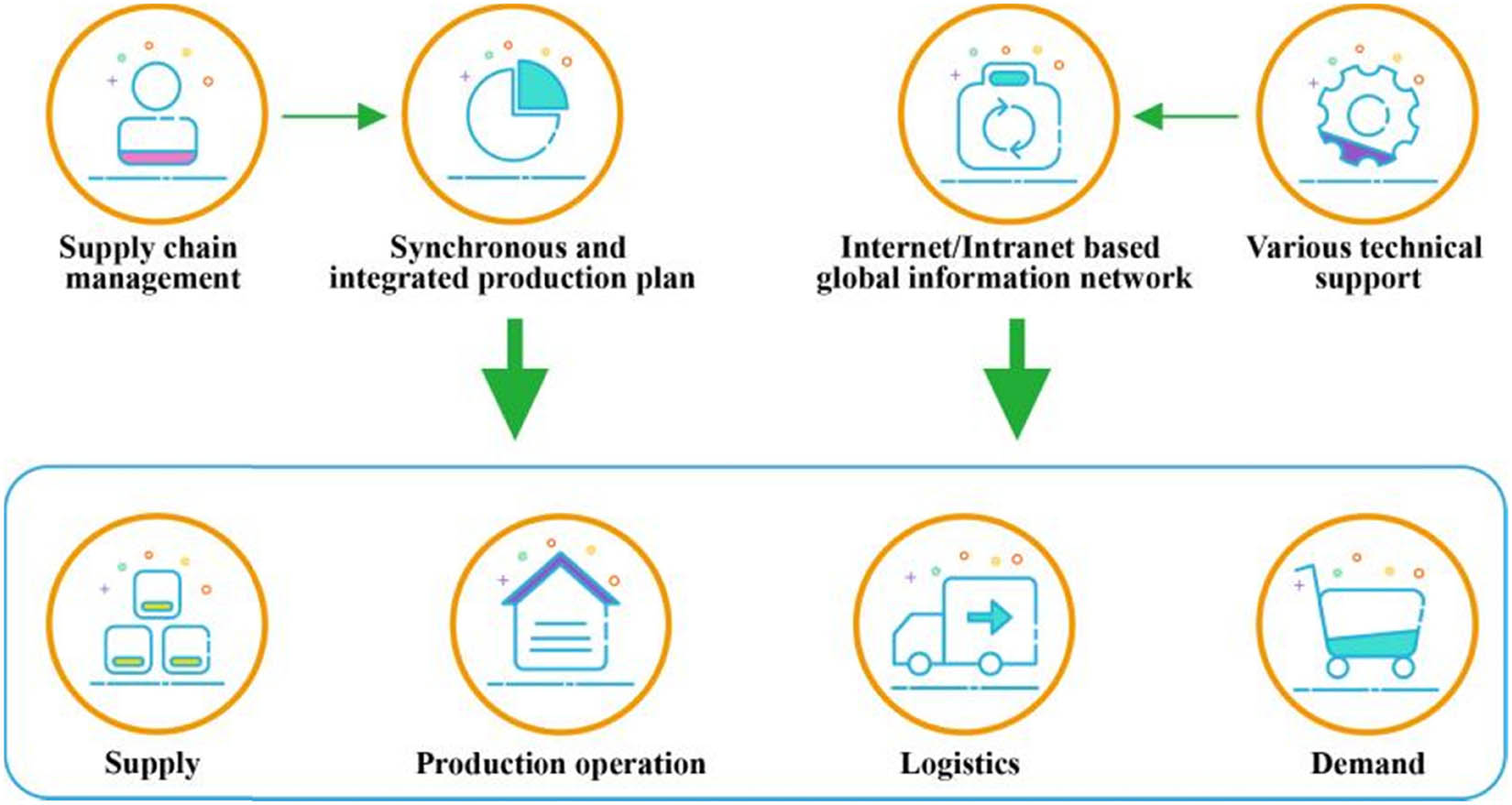
Supply chain management structure diagram.
2 Literature Review
In the early study of flexibility, many scholars believed that flexibility is a measure of the strain capacity of supply chain resources. Mandalbaum points out that flexibility is a kind of executive ability of a supply chain to cope with changing environment, and Gupta points out that supply chain resources have the attribute of multi-mode executive ability, and flexibility is a kind of strain ability to deal with external changes quickly. Zhang & Zhang (2022) divided manufacturing flexibility into multiple dimensions including machine flexibility and mixed flexibility to study manufacturing resources (Zhang & Zhang, 2022). At the same time, they concluded that the higher the flexibility of resources, the stronger its ability to cope with the changes in manufacturing objects. Figure 3 illustrates a low-carbon material.
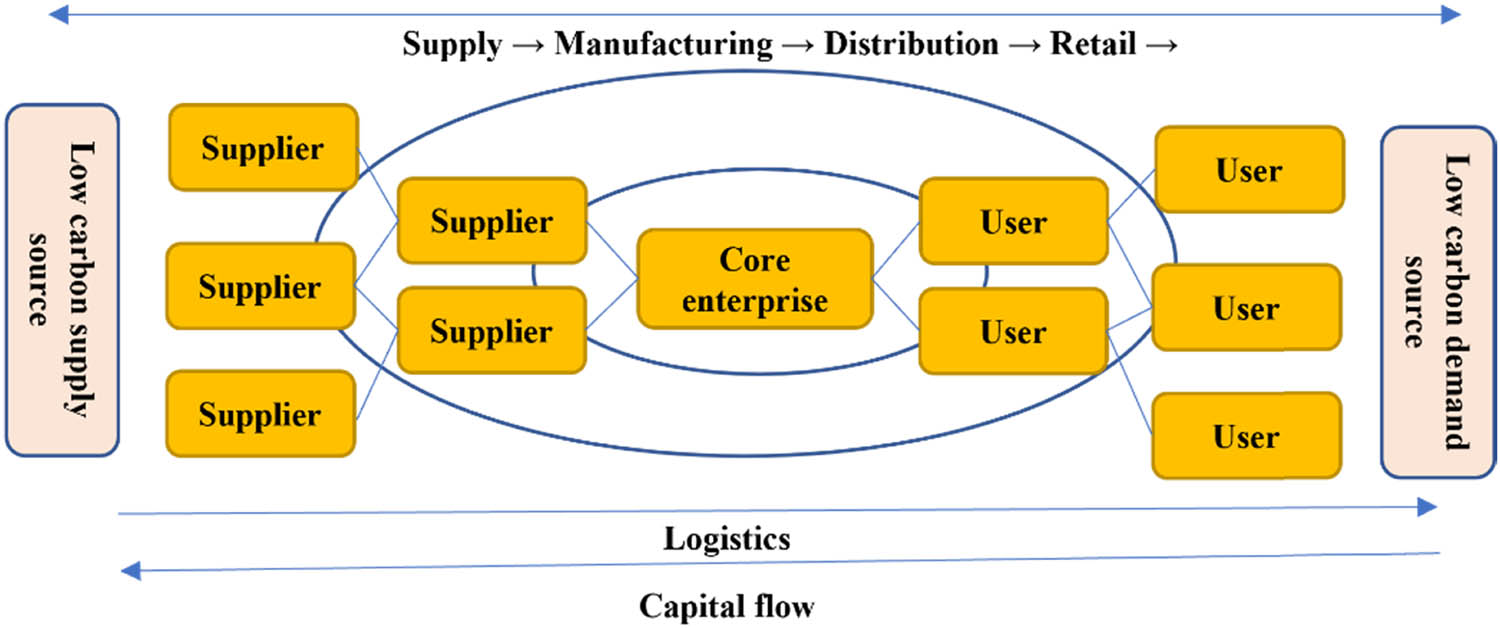
Model of low-carbon supply chain network structure.
Through an analysis of Aliahmadi et al. (2022), the AIoT-based supply chain’s dimensions and components, the research sought a deeper understanding of how these technologies affect fairness. On the other hand, the supply chain’s resilience is its capacity to withstand and even thrive in the face of extreme stress. Supply chain resilience may be enhanced via AI and the Internet of Things (IoT), essential in recent years in enhancing supply chain performance. We conclude by identifying the most critical effect factors on the robust smart supply chain using a nonlinear fuzzy decision-making approach. The smart supply chain may benefit from an understanding of this evaluation.
The elements and dimensions were ranked using the IT2FS-AHP approach, which stands for Interval Type-2 Fuzzy Analytic Hierarchy Process in the study by Andalib Ardakani et al. (2024). The significance of each dimension and aspect was determined by collecting expert views via a questionnaire. In addition, the factors that were found to have a significant impact on the success of green supply chain management include “Attention to social responsibility in the organization,” “Design and development of evaluation and selection systems of suppliers based on environmental criteria,” and “support of operational, middle, and senior managers in implementing the green supply chain.”
Using a mixed method, route analysis, SWARA, and TOPSIS, the article (Mansory et al., 2021) aims to rate the performance of resilient and environmentally conscious suppliers at Fanavaran Petrochemical Company and determine which resilience criteria are most beneficial. To achieve their aims, the researchers use a descriptive-survey research strategy for gathering information. The research’s suggested methodology offers a helpful conceptual framework for business leaders to enhance suppliers’ environmental problems and resilience situations.
The projection of DMUs on the efficient frontier is captured by centralized allocation resource (CRA) using a two-stage linear programming model in the study Mozaffari and Ostovan (2021). However, there is a chance that the input and output vectors of every DMU in the DEA are just random data following a certain distribution, notwithstanding how important they are. You may find out how efficient a decision-making unit is and where its inefficiencies are on the efficient frontier by using data envelopment analysis based on mathematical programming. Thus, random data are a problem for many applicable investigations. This work presents a two-stage supply chain that utilizes ratio data and the CRA model to project DMUs. The data utilized in the chain are randomly generated.
Low-carbon performance is an important embodiment of a low-carbon supply chain and also low-carbon performance of companies in the export improvement industry. Therefore, the significance of low carbon content in low carbon chain management must be emphasized. Low carbon performance is greatly influenced by low carbon content, cutting-edge technology, and environmental factors. Some scientists have argued that pollution control has a major impact on the low efficiency of low carbon emissions by industry standards, and the environmental characteristics of capital. Hidden layer affects the low efficiency of the business (Liu et al., 2020). At the same time, it was pointed out that the direct impact of pollution control of low-carbon materials is greater than the direct effect, and the efficiency of low-carbon can be improved by improving the environmental characteristics of the chain equipment (Peng et al., 2020).
A low-carbon economy may be achieved by a variety of means, including but not limited to promoting the shift to renewable energy sources, conserving and maximizing the use of energy, capturing and storing carbon emissions, implementing climate-smart agricultural practices; and electrifying transportation (via, for example, electric cars). One example is cities that produce no carbon emissions at all. The goal of supply chain optimization is to improve a supply network’s effectiveness and efficiency by using tools and resources such as blockchain, AI, and the IoT. A well-oiled supply chain is an essential component of every customer-centric company model. Faster answers and an improved customer experience are made possible by optimizing supply chain operations, which boost end-to-end visibility and provide actionable information. The top and bottom lines benefit from this as it aids client retention and gives a competitive edge. Save a tonne of money by streamlining your supply chain using real-time data, predictive analytics, and historical records. Cooperation: By forming partnerships with essential parties such as distributors and suppliers, businesses may ensure that their supply chain activities go more smoothly. Establishing efficient planning and coordination throughout the delivery supply chain is crucial to guarantee on-time delivery of items. The following are part of it: precise demand forecasts, well-planned manufacturing, simplified logistics, and proactive contact with clients and vendors. In Figure 4 below, a platform management device is shown.
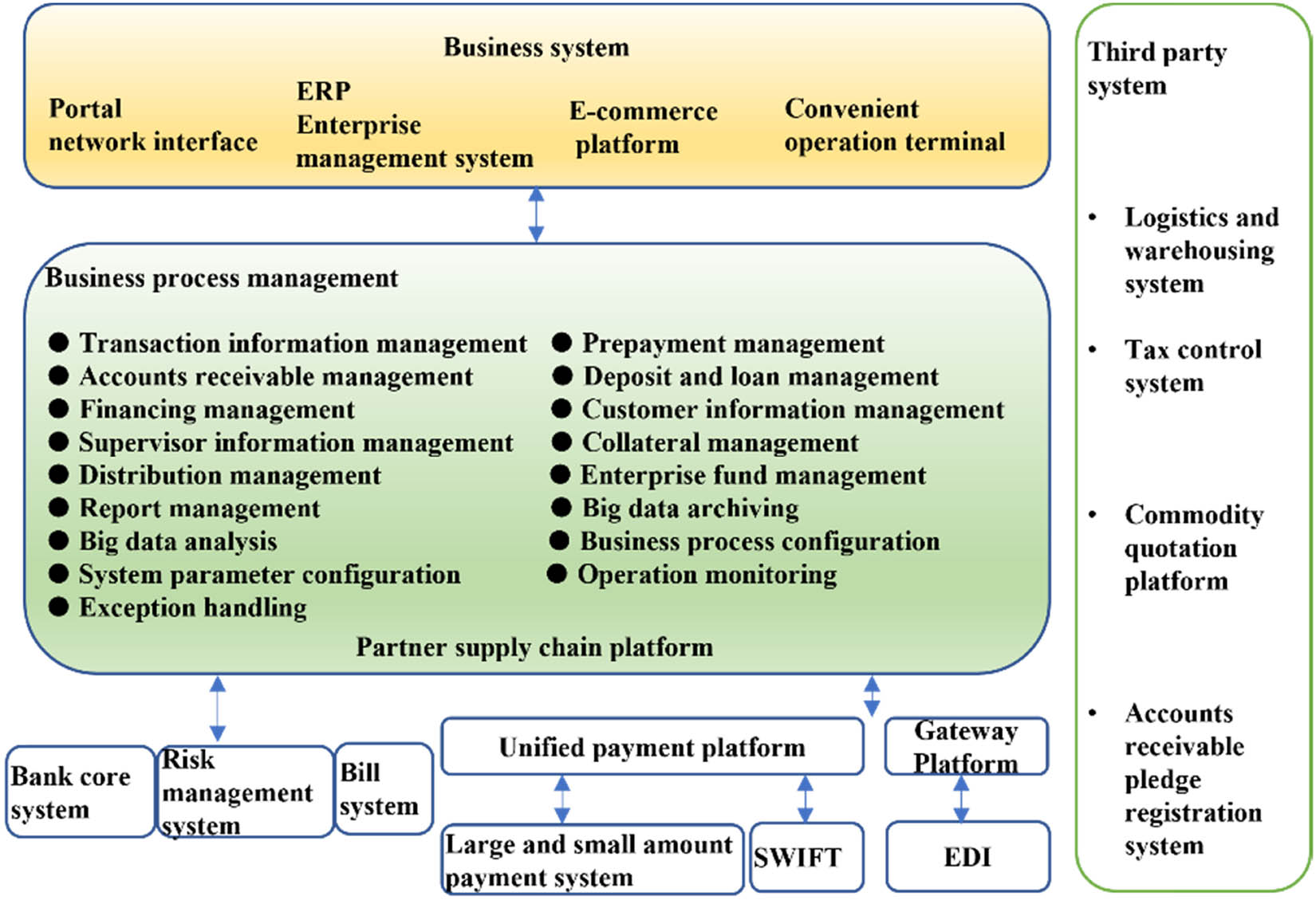
Supply chain management platform diagram.
3 Sustainable Development Requirements of Low-Carbon Supply Chain Economy based on IoT and Environmental Responsibility
For the sector to have a higher competitive edge, managing low-carbon chains is essential. Given how widely accepted the concept of a low-carbon economy is, people’s awareness of environmental protection is increasing day by day, and consumers are choosing more environmentally friendly products. Reducing expenses through green supply chain management is the only option. Expert analysis shows that from production to sales, production and turnaround time is only 10%, and nearly 90% is transportation, loading and unloading, sub-packaging, secondary processing, document processing, and other logistics processes. Large loads and small equipment are the characteristics of low-carbon supply chain management, thus saving and reducing operating costs, including low carbon, energy saving, high efficiency, and pollution. less, with larger results, production, and operation cost savings (Xia et al., 2020). In this way, by maintaining the green supply chain, consumers can get better products, and businesses can get long-term business cooperation and improve businesses’ competitive advantage. Using the IoT to enhance supply chain management is known as the Internet of Supply Chain (IoSC). From the procurement of raw materials to their ultimate delivery, this network of interconnected devices, sensors, and software records information on the supply chain. IoT sensors track carbon and trash, cut energy use, and produce renewable energy locally. According to a new analysis, “Smart energy sector initiatives might save over 2 billion metric tonnes of carbon dioxide yearly.” The IoT and GPS trackers enable the real-time tracking and monitoring of assets, including containers, parcels, and cars. As a result, everyone in the supply chain can see who is responsible for what. Increased efficiency and productivity brought forth by the IoT trend will change how we live and work very soon. Supply Chain Management will keep maximizing profits by enhancing industrial throughput, increasing material tracking, and optimizing distribution with this cutting-edge technology as shown in Figure 5.
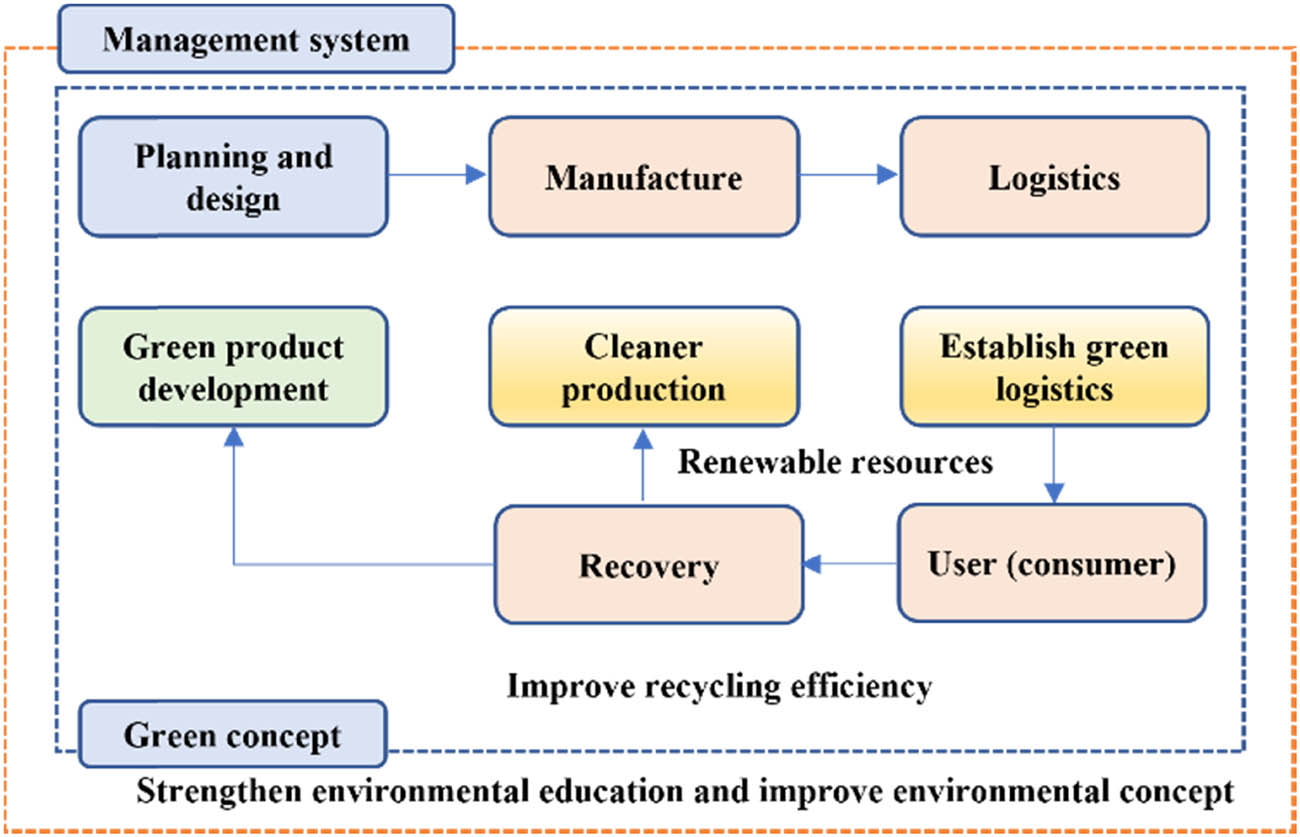
Supply chain management system diagram.
3.1 Realization of Basic Algorithm for Sustainable Development of Low-Carbon Supply Chain Economy based on IoT and Environmental Responsibility
3.1.1 Model Description
This essay investigates the product marketing cooperation system of a low-carbon supply chain, which consists of a single manufacturer (D) and a single retailer (C) under the influence of the delay effect (Zhang et al., 2021). Hypothesis 3–1: Both parties aim to maximize their own benefits and are completely rational and have complete information. Regarding the promotion of low-carbon products, producers’ and retailers’ tasks are E D(t) and E C(t), λ D > 0 and λ C > 0 represent the marketing cost coefficients of manufacturers and retailers, respectively. The actual expressions of marketing costs C D(t) and C C(t) of both parties are shown in formula (1).
Hypothesis 3–2: The more favourable the product’s low-carbon reputation is, the more it can improve consumers’ purchase intention and trust in the product. Suppose G(t) indicates supply chain goodwill with minimal carbon. In such cases, the system’s starting condition is G(0) = G 0; α and β represent the influence degree of manufacturer’s and retailer’s efforts in low-carbon product marketing on low-carbon goodwill, namely, marketing effort level coefficient. ds and dz represent the delay time of manufacturer’s and retailer’s marketing effort strategy ℇ, respectively; Manufacturers’ and retailers’ low-carbon supply chain marketing initiatives are displayed in Figures 6 and 7 below. δ > 0 represents the attenuation coefficient of low-carbon goodwill in a low-carbon product marketing system. Based on the N-A model, considering the delay characteristics of marketing efforts in practice, the following delay differential equation is used to explain how product goodwill varies dynamically (2):
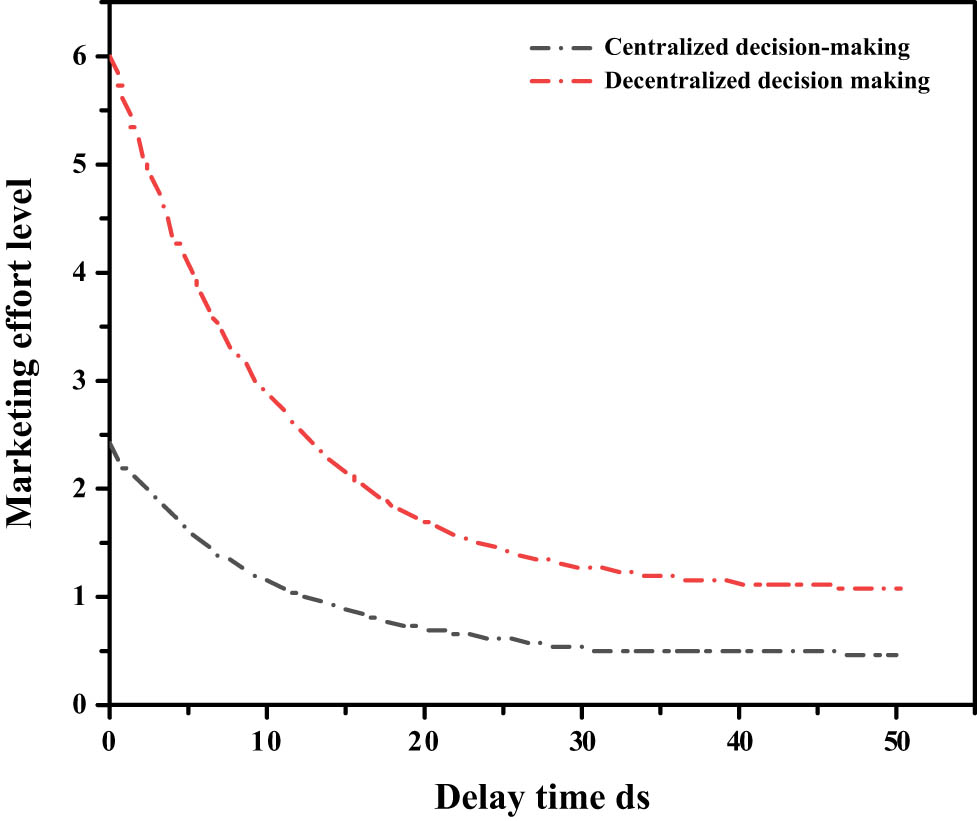
Comparison of retailers’ marketing efforts and strategies.
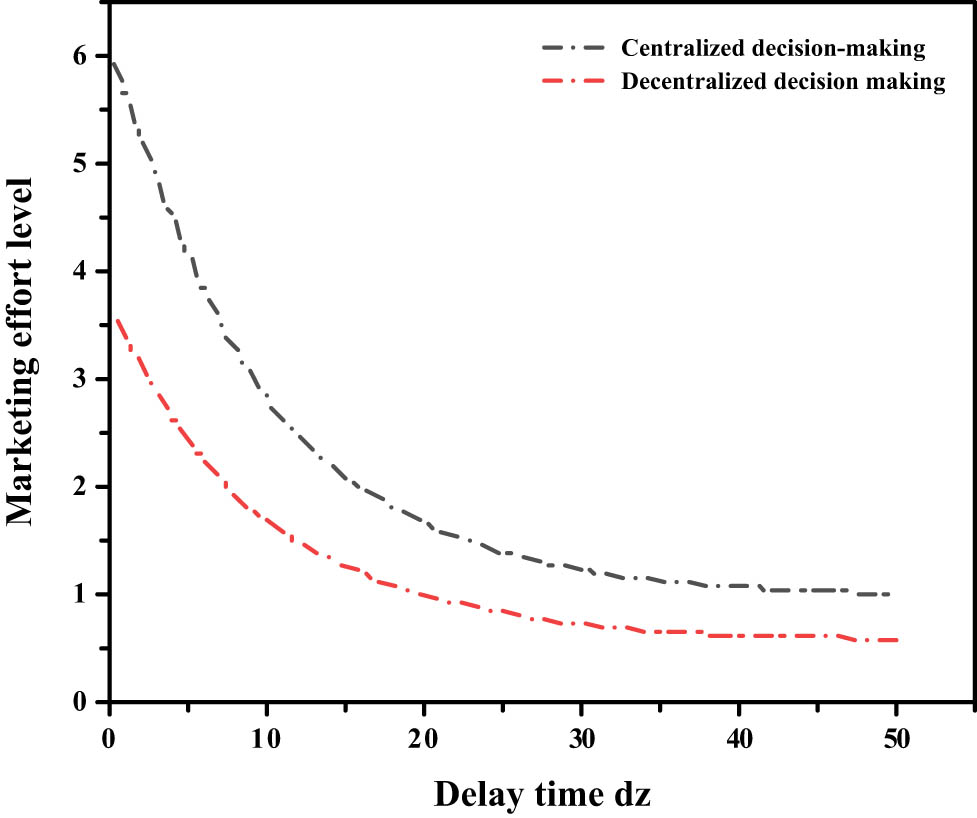
Comparison of manufacturers’ marketing effort strategies.
The delay time exists in three cases: DS is greater than Dz, DS is less than Dz, and ds is equal to Dz. If DS is greater than Dz as an example, the G(t) segment is brought into the evolution of low-carbon goodwill. In the whole time range, its interval is (0, DS), (DS, DZ), (DS, ∞). The first time interval is the initial point of G 0, and the initial value of the second interval is the right endpoint of the first interval, and so on. As shown in Figures 8–10.
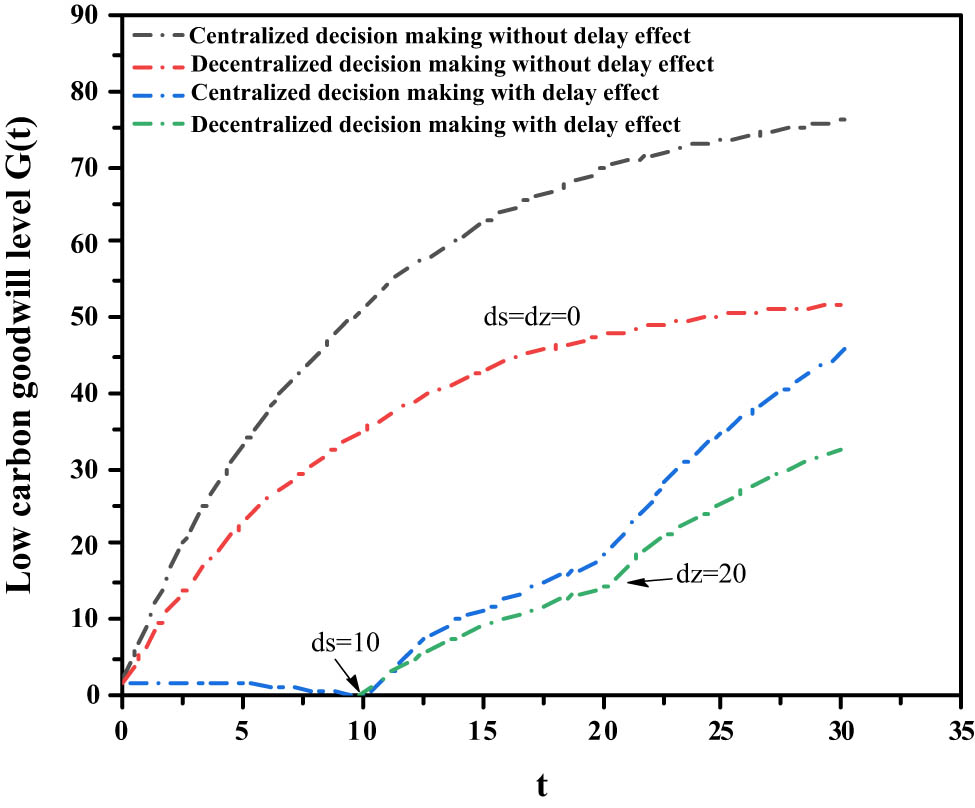
Evolution of ds greater than dz low-carbon goodwill.
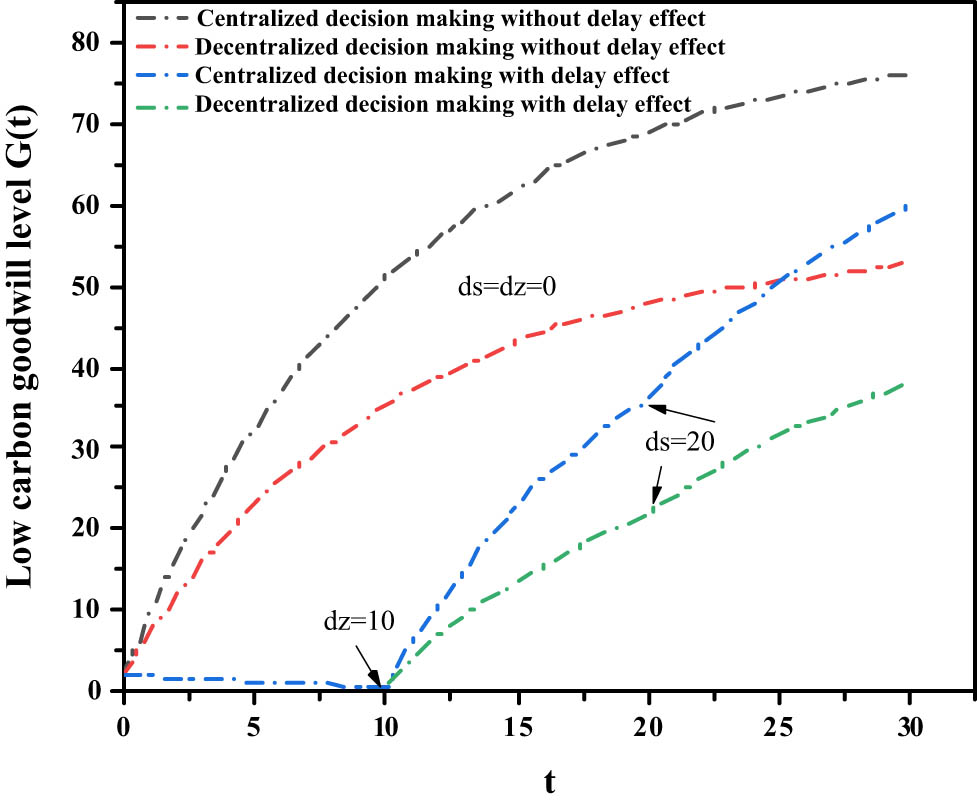
Evolution of low carbon goodwill with ds less than dz.
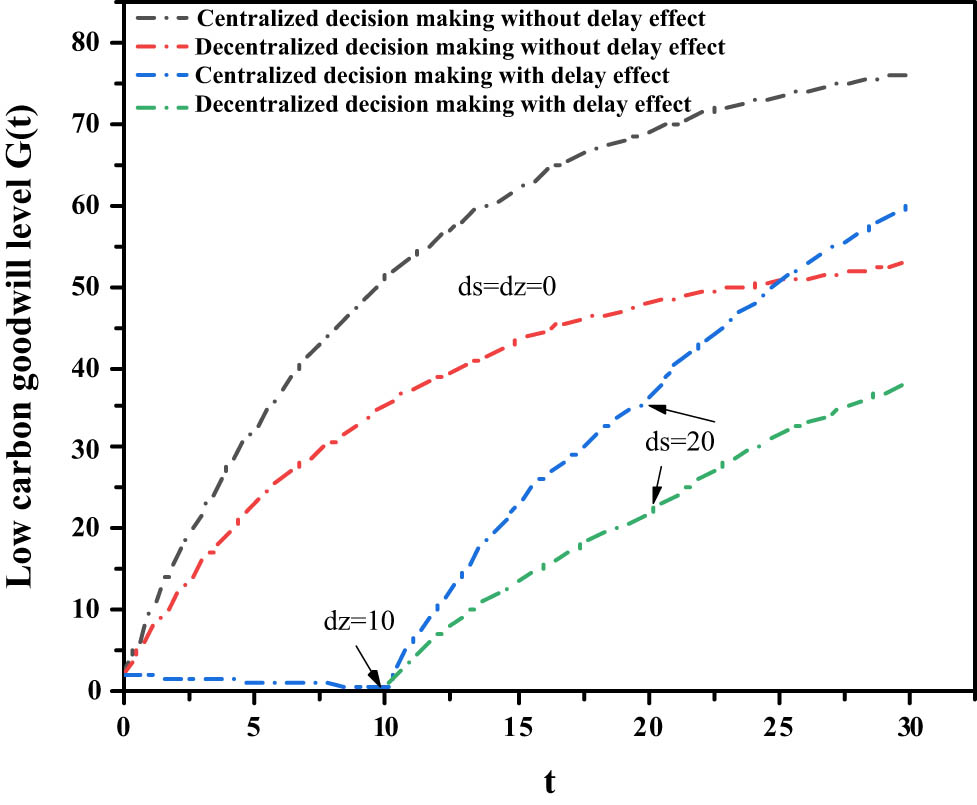
ds Equals dz low-carbon goodwill evolution process diagram.
Hypothesis 3–3: The income obtained from the marketing cooperation system of low-carbon product supply chain is distributed between the two cooperative entities, and the income distribution coefficient is determined for both parties in advance. Where the retailer gets (0, 1), the manufacturer gets 1–. In actual production, in order to encourage retailers to conduct low-carbon product marketing, manufacturers will take the initiative to bear the marketing cost of (t) for retailers. (t)(0, 1) represents “subsidy factor” (Li & Gong, 2020). In the infinite time zone, the goal of both companies is to seek the optimal marketing effort strategy to ensure the maximization of their respective income. Both parties discount their future earnings at a fixed rate of 0. The manufacturer’s objective function is formula (3):
3.2 Delayed Effect
As shown in equation (4)
In this formula, E is the mathematical expectation, t, x(t) is the matrix m*
The delayed effect is included in the study of the marketing cooperation system of low-carbon supply chain, and the case where the delayed effect exists in the marketing effort strategies of both manufacturers and retailers of low-carbon products is also considered. A two-delay differential game model is constructed under a dynamic environment, and the evolution process diagram of low-carbon goodwill of products is drawn according to the different relationships between two delay times. The influence of the delay effect on system optimal profit and low carbon goodwill is analysed. The decision basis and the effect of the manufacturer’s subsidy ratio on the retailer’s marketing effort under the double delay effect are explored, which gives the corresponding management enlightenment (Ghosh et al., 2020). This helps to gather useful information for the low-carbon supply chain marketing cooperation system’s participants to use it as a foundation for decision-making and to offer an accurate theoretical direction for promoting the growth of low-carbon supply chain marketing cooperation.
3.3 Low Carbon Supply Chain Energy Saving Technology in Economic Production
Therefore, first, it seeks to increase investment in science and technology, increase new democratic capabilities, and measure integration, modification, and use of technology. Second, it improves the development and use of low-carbon sources such as nuclear power and hydropower, and continues to improve the carbon sequestration of ecosystems. Third, government regulation will be tightened, and companies will be brought in to promote regulation and reduce energy consumption while operating. This encourages driving forces to improve driving skills and reduce energy consumption by driving the industry at high speeds (Xi & Zhang, 2022).
Green supply chain management is a completely new management concept. It wants companies to focus on long-term interests, bring all products as a starting point, and build a network of partnerships, partnerships. share information, and relationships of all members, who want senior leaders to change and improve their strategies and knowledge of the stable development of the industry. Environmental protection is the desired goal of the law in the field of improving human health and the economy. Company leaders should actively link business goals, environmental goals, and relationship goals to the chain so that employees and vendors have access. The authors emphasize on the importance of environmental protection in the industry (Meng et al., 2021; Zhu et al., 2021).
Within the bounds of stringent carbon emission restrictions, low-carbon supply chain coordination aims to maximize overall supply chain, retailer, and manufacturer profitability. If they did, companies in the manufacturing sector would benefit overall from cutting their carbon emissions. Still, they are less likely to do so due to concerns like “free riding” and the high cost of low-carbon production. For now, academics primarily focus on researching and developing different contracts to persuade companies to help reduce emissions and improve supply chain coordination. One kind of contract relevant to this investigation is a revenue-sharing contract. However, there are others, such as quantity discount contracts, two-part pricing contracts, revenue-sharing contracts, and cost-sharing contracts.
Consequently, these contracts have been the primary focus of study in supply chain management. To manage the supply chain and share the total profit arbitrarily, the revenue-sharing with reliability (RSR) contract in the N-stage supply chain, considering the members’ dependability. The dynamic situation by permitting inventory carryover in discrete time provides a basis for modifying the revenue-sharing contract in the incentive mechanism, in contrast to the work above which just examined the static case. While many studies have examined traditional supply chain coordination, few have considered revenue-sharing arrangements in low-carbon supply chains. More stringent regulations meant to reduce carbon emissions have led to a shift in consumer preference towards low-carbon items, and the degree to which shoppers care about the environment affects how well businesses do in this area. New carbon emission constraints have transformed the demand and profit functions of the client, provider, and global supply chain in the case of low-carbon supply chain coordination. With carbon emission limits in place, low-carbon supply chain management aims to maximize profits for all parties involved. Various solutions, including total limits, carbon subsidies, and carbon taxes, have been included in the plan for supply chain coordination – the societal costs of carbon emissions in their supply chain design choice model. The above explanation leads us to conclude that the decision factors, including production amount, order quantity, and the conventional supply chain coordination method, need modification in light of the growing demand for low-carbon goods among consumers. Figure 11 depicts the structural model of the low-carbon resilience mechanism.
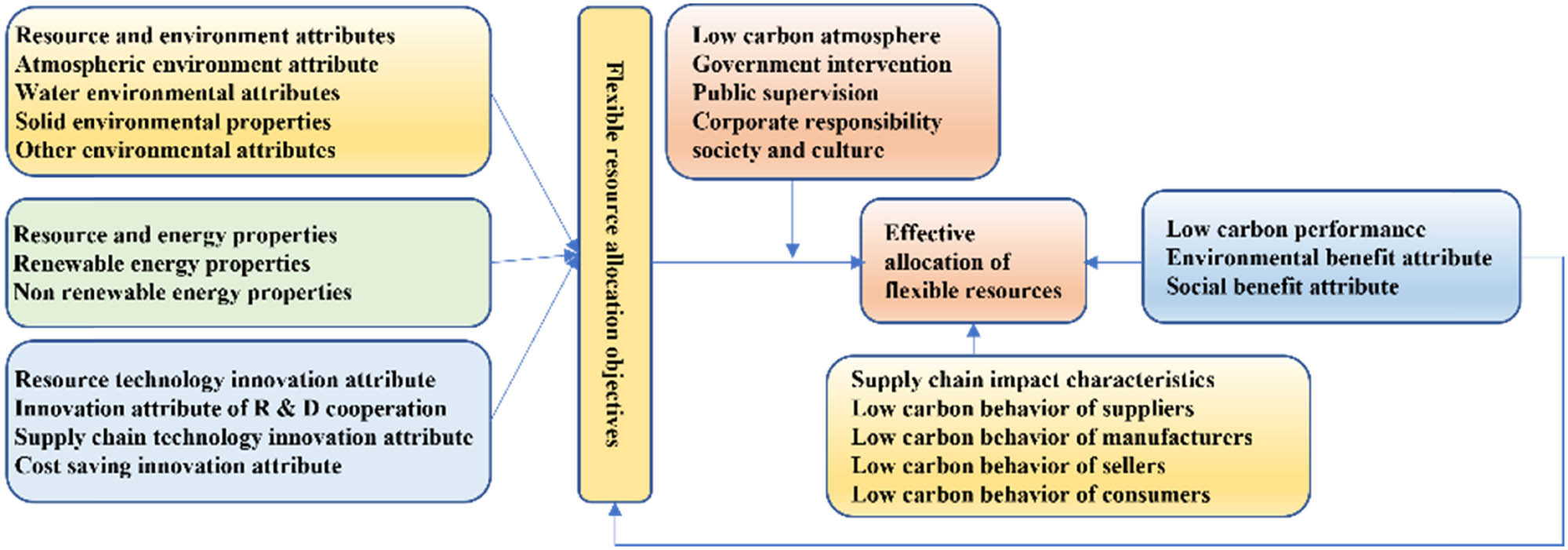
An attribute-based structural model of the low-carbon supply chain’s flexible resource allocation mechanism.
Enterprises should focus on the green supply chain as a guide to restructure the enterprise operation system, set up green management departments, formulate statistics, monitoring and assessment methods for carbon emission reduction, improve the management system and supervision and implementation mechanism, and provide institutional guarantee for low-carbon production and manufacturing. We should actively adjust the production system, speed up the phasing out of outdated production capacity, processes, technologies and equipment, strengthen energy conservation in production and buildings, carry out green procurement and green services, and actively solve resources and environmental issues that have an impact on enterprises’ ability to develop sustainably. While suppliers reside upstream in the supply chain, green supply chain management emphasizes collaboration across every enterprise in the chain (Dhiman et al., 2021). Every supply chain node will get a transmission of their actions, and cost savings can be transmitted to all parts of the supply chain, thereby improving overall efficiency.
Using the TBL as a framework, it illustrates the impact of the IoT on the social, economic, and environmental spheres. There is evidence that the IoT may assist in lowering industrial value chains’ energy consumption and CO₂ emissions by 20–30% via optimization, tracking, monitoring, and design evolution according to TBL dimensions. Through continuous communication, preventative maintenance of monitoring devices and robots, and automated or semi-automated activities, the IoT may boost profitability. Businesses in the logistics industry use it to track the whereabouts of cars and products in real time. After that, the logistical data are returned and analysed to aid decision-making. Enterprise Information System 4 (EIS) receives real-time task data uploaded by the real-time information sensing and processing system. By keeping tabs on the state of the roads using GIS, path optimization algorithms can determine and display the best possible transportation routes. The innovative Internet-based transactions may reduce recovery-related environmental costs by collecting garbage from the whole supply chain more quickly and sustainably. With these capabilities, the IoT may increase profits while decreasing needless pollution. Additionally, IoT can make workplaces safer for employees and increase transparency in value chains and business models for commerce partners. The increased openness that promotes ethical conduct among company stakeholders and partners boosts companies’ credibility and collaboration within the logistics sector, however, to evaluate the sustainability effects of the IoT on green logistics, advocated for establishing a new industrial-level assessment methodology. As a result, we create an indicator system to measure the sustainability performance of the logistics sector in response to IoT initiatives.
3.3.1 Evaluation Framework Variables
Considering the objectives from the TBL dimensions, green logistics illustrates the coordination of material, informational, and financial flows throughout the supply chain. The key enablers of green logistics practices are supplier relationship management (SRM), total quality management (TQM), increased value added (VA), increased compensation for full-time equivalent employees (FEEC), green technology adoption (GTA), and reduced pollution and CO2 emissions (RE).
3.3.2 Total Quality Management
TQM is a popular method for managing both operational costs and product quality. Since quality management is seen as an indicator of economic management maturity, it probably impacts the performance of green logistics. In addition, companies that adopted TQM had higher total factor productivity (TFP). Given our interest in three distinct underlying dimensions, we divide the TFP into labour productivity (LP), which is defined as VA generated per year per full-time equivalent employee employed, and capital productivity (CP), which is defined as VA generated per year divided by the total annual expenses (including transportation, storage, and management expenses) in logistics. LP describes the labour inputs to TFP, while CP describes the capital inputs. Management of relationships with suppliers is SRM.
The need for supplier collaboration for environmentally friendly logistics shown in this article. Specifically, they said supplier collaboration and other inter-organizational cooperation improve sustainability performance. Suppliers who put money into their relationships with customers are likelier to keep doing business with them or grow them. A supplier would want to work with the same purchasing company over the long haul to recoup its initial investment. Both companies’ operational and buying expenses will decrease, and the integration between the two will get stronger as a consequence. In addition to that, these expenditures lessen production-related environmental expenses while raising product quality and considering how difficult it is to get relationship-specific investment data in the logistics sector. Logistics firms may use FDI and fixed assets investment to mimic the SRM effect and achieve green transformation. They aim to improve supplier relationships and produce cleaner manufacturing by promoting technology dissemination via imitation learning, people, and capital movement.
3.3.3 The Use of Eco-Friendly Technology (GTA)
Contributions of green-tech patents represent the logistics industry’s development towards a more environmentally friendly future. Through an analysis of cleaner unit process development, the significance of green technology in mitigating the environmental consequences of industrial operations is evaluated. In China, most green-tech logistics companies are SMEs known for innovation. Consequently, pinpointing their R&D spending on certain eco-friendly technology is a challenge. However, the GTA may be approximated by looking at the total number of patents related to green technology.
The goal is the reduction of pollution and CO2 emissions. Lessening of environmental stresses, such as carbon and fine particle emissions, indicates the logistics industry’s sustainability performance. These two aspects are fundamental when considering China’s 11th–13th Five-Year Plans. There is a link between the logistics industry’s energy conservation efforts and a decrease in carbon emissions, and reducing carbon emissions is considered a critical facilitator of greener logistical practices. One of the most dangerous air pollutants is PM 2.5. One of the main sources of particulate matter emissions is the logistics industry.
Tables 1 and 2 show the test table of the suitability index of a low-carbon supply chain’s fundamental resource allocation model:
The suitability index examination of the fundamental resource distribution model in low-carbon supply chain
| Simulation fit index | Parameter values | The critical value | Structure |
|---|---|---|---|
| GFI | 0.913 | >0.9 | Acceptance |
| RMSEA | 0.06 | >0.9 | Acceptance |
| NFI | 0.954 | >0.9 | Acceptance |
Verification table of influence path data of flexible resource allocation in low-carbon supply chain
| Research on path | Estimation | Standard estimation | CR | SE |
|---|---|---|---|---|
| Renewable energy | 0.113 | 0.148 | 0.031 | 2.874 |
| Non-renewable energy | 0.152 | 0.397 | 0.037 | 3.371 |
| Technology | 0.502 | 0.453 | 0.046 | 6.757 |
| Research and development | 0.101 | 0.117 | 0.028 | 3.361 |
4 Design of Resource Allocation Parameters of Low-Carbon Supply Chain based on IoT and Environmental Responsibility
4.1 Create a Low-Carbon Supply Chain with Flexible Resource Allocation Parameters
In order to improve and effectively improve the characteristics of flexible substrate in low-carbon materials, and to enhance resource distribution level and efficiency, this article specially designed the exchange capital of low-carbon products. The parametric design diagram of a hybrid neural network model is shown in Figure 12.
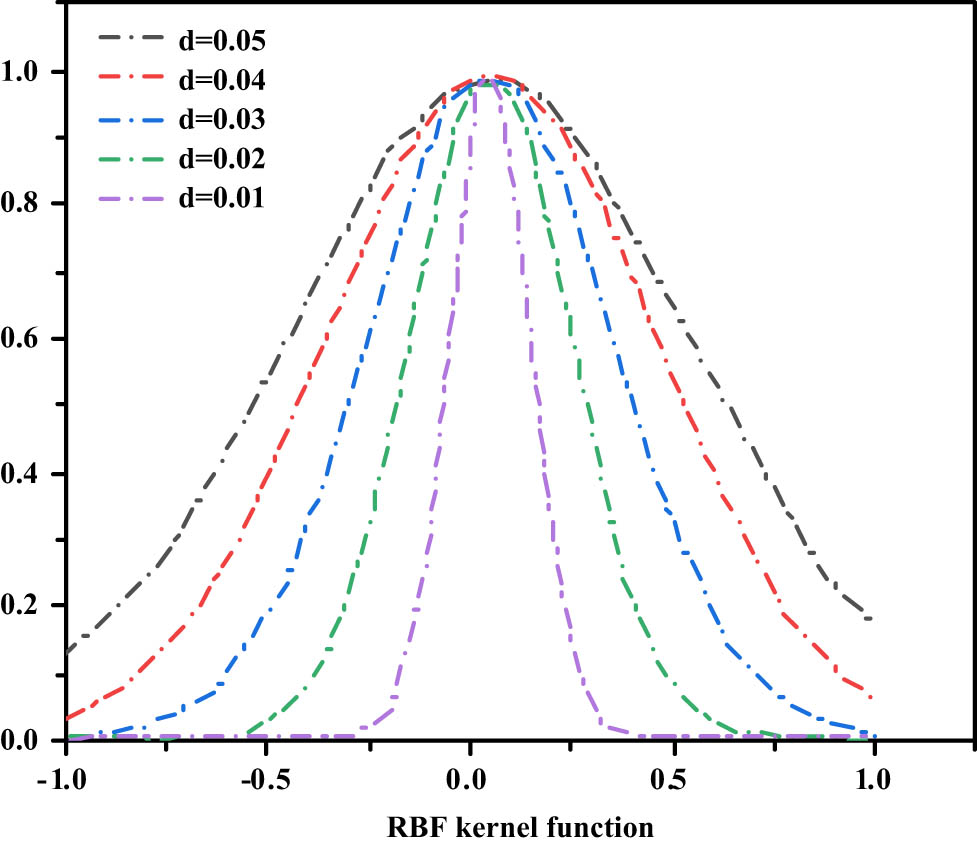
Structural parameter design of hybrid neural network based on radial basis function.
Therefore, it is necessary to design the configuration parameters according to flexible resources’ characteristics in the low-carbon supply chain, and finally achieve the low-carbon supply chain’s overall optimization objective for flexible resource allocation parameters. In the analysis of resource and environmental attribute list of low-carbon supply chain, attention should be paid to the collection of data, the extraction of effective attribute characteristics, and the elimination of redundant characteristic attributes (Liu et al., 2021). Then, a complete set of flexible resources and environmental attributes of low-carbon supply chain. They can be established to analyse the characteristics of flexible resources and environmental attributes of low-carbon supply chain and other relevant information, so as to clarify the consumption of flexible resources in the production chain and how environmental characteristics are affected. Ensure reasonable allocation of flexible resources in low-carbon supply chain to achieve the overall optimization goal of reducing energy consumption and environmental pollution. Therefore, it is difficult to analyse the allocation of flexible resource attributes in low-carbon supply chain. The flexible resource allocation parameter design of low-carbon supply chain is also reflected in the uncertainty of data and the unbalanced performance of neural network structure in the configuration process, which is also related to the robustness analysis of the configuration model and hybrid algorithm below. In the low-carbon supply chain, Tables 3 and 4 demonstrate the attribute characteristic scale of flexible resource allocation (Huang et al., 2021).
Influence the flexible resource allocation scale’s distinguishing attributes in the low-carbon supply chain
| Attribute feature name | Code | Characteristic measurement term |
|---|---|---|
| The atmosphere | RS1 | Carbon dioxide emissions |
| The water | RS2 | Wastewater discharge |
| Solid state | RS3 | Solid waste disposal rate |
Descriptive statistical analysis of research samples
| Attribute code | N | Statistical value | Standard error | Quantity of statistics | Quantity of statistics | Quantity of statistics | Quantity of statistics |
|---|---|---|---|---|---|---|---|
| RS1 | 500 | 4.32 | 0.039 | 0.877 | 0.769 | −0.837 | 0.875 |
| RS2 | 500 | 4.21 | 0.038 | 0.843 | 0.711 | −0.339 | 0.757 |
| RS3 | 500 | 3.27 | 0.036 | 1.032 | 1.066 | −1.640 | 0.252 |
| RS4 | 500 | 3.25 | 0.040 | 1.003 | 1.077 | −1.654 | 0.365 |
| RS5 | 500 | 3.35 | 0.039 | 0.976 | 0.952 | −1.843 | 0.415 |
Therefore, the parameters design of flexible resource allocation in low-carbon supply chain should mainly pay attention to the following aspects: in the structure of the hybrid quantum neural network, the learning efficiency value should be mainly paid attention to. Therefore, this article suggests using the adaptive learning rate of the hybrid quantum neural network’s structural activation function design, which is based on the radial basis function of the Gaussian function, to enhance the algorithm’s convergence performance (Guo et al., 2021). The basic structural equation model of resource allocation elements of low-carbon supply chain is shown in Figure 13.
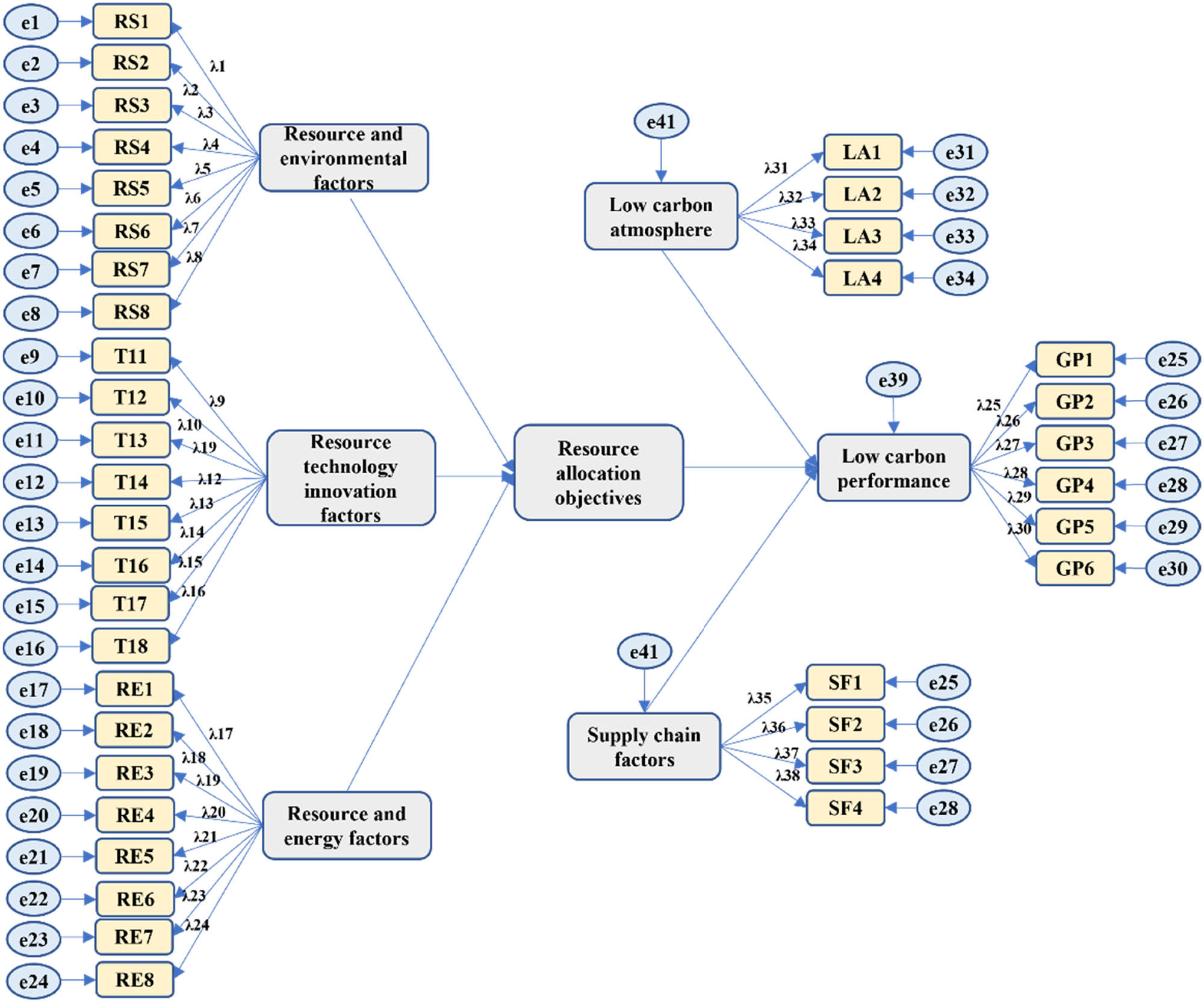
Basic structural equation model of resource allocation elements in low-carbon supply chain.
Cloud-based hybrid quantum neural network algorithm must first correct the radial root function and its target error. The maximum weight vector generated by the network is used to process the hidden new neuron of the hybrid neural network structure, so that the iteration finally reaches the maximum number of neurons. Meanwhile, the hybrid quantum particle optimization technique is used in this work to optimize and repair the hybrid neural network and uses the network weight training algorithm to achieve the most efficient results of body weight training. In this letter, in the process of exchanging capital in a low-carbon supply chain, the behaviour of flexible resources is divided according to the clustering criterion of the system. Intermediate algorithm minimizes the flexible resource allocation error in a low-carbon supply chain as a result.
4.2 Hybrid Quantum Neural Network Algorithm for Low Carbon Supply Chain
The parameters of the structure hidden layer must be chosen for the hybrid quantum neural network depending on the cloud model, and the activation function of the hybrid network structure should be optimized. The hybrid algorithm can improve the overall performance of the network structure by using quantum particle swarm optimization. If the proper basis function is selected, the approximation ability of the function can be improved, so the convergence speed of the algorithm will be reduced. Therefore, in order to ensure the convergence performance of hybrid network structure learning and effectively improve the generalization ability of algorithm network structure, this essay applies the appropriate hidden layer node number and appropriate basis function of network structure. In this essay, the combination calculation of hidden layer connection weight is designed to improve effectively Network structure stability. In this way, the hybrid quantum particle swarm optimization algorithm can effectively avoid the unstable performance of network structure caused by improper parameter selection and improve the hybrid quantum neural network structure’s control performance efficiently. Figure 14 below displays the structure of the algorithm.
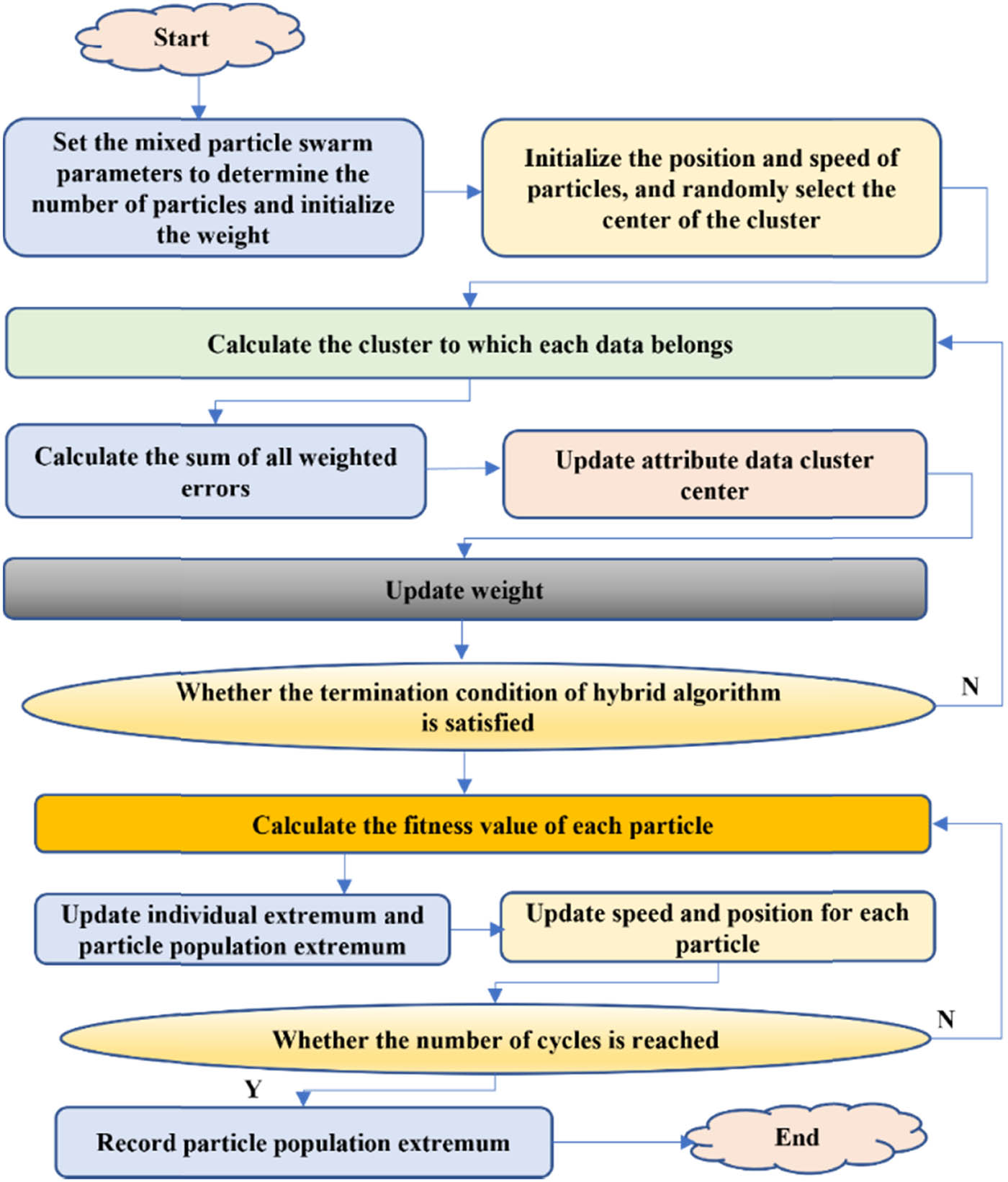
Basic algorithm structure diagram.
In this essay, when constructing the hybrid quantum neural network structure based on the cloud model, the Gaussian function was chosen as the neural network’s activation function. A quantum neural network may be classified as a classical computer with quantum data, a quantum computer with classical data, or a hybrid of the two. By mixing multiple kinds of algorithms, hybrid algorithms can achieve quicker convergence and greater enhancement. More so, hybrid algorithms may outperform purebred optimization techniques regarding engineering challenges. Superposition and entanglement in quantum computing allow QNNs to handle massive volumes of data concurrently, giving them a computational advantage over traditional neural networks. For certain issues, QNNs may be able to provide a quantum speedup, allowing them to be solved more quickly than with conventional computers. The capabilities of conventional neural networks are greatly enhanced by QNNs, which use quantum concepts such as entanglement and superposition. These sophisticated networks excel at processing massive, complicated information, which makes them perfect for data-intensive jobs and nuanced pattern identification. The specific activation function design of the hybrid network structure is shown in formula (5) below:
where
where Y n shows the hybrid quantum neural network structure’s output value following training, Y J is the hybrid quantum network structure’s sample size and N is the hybrid network structure’s actual value (Figure 15(a) and (b)):
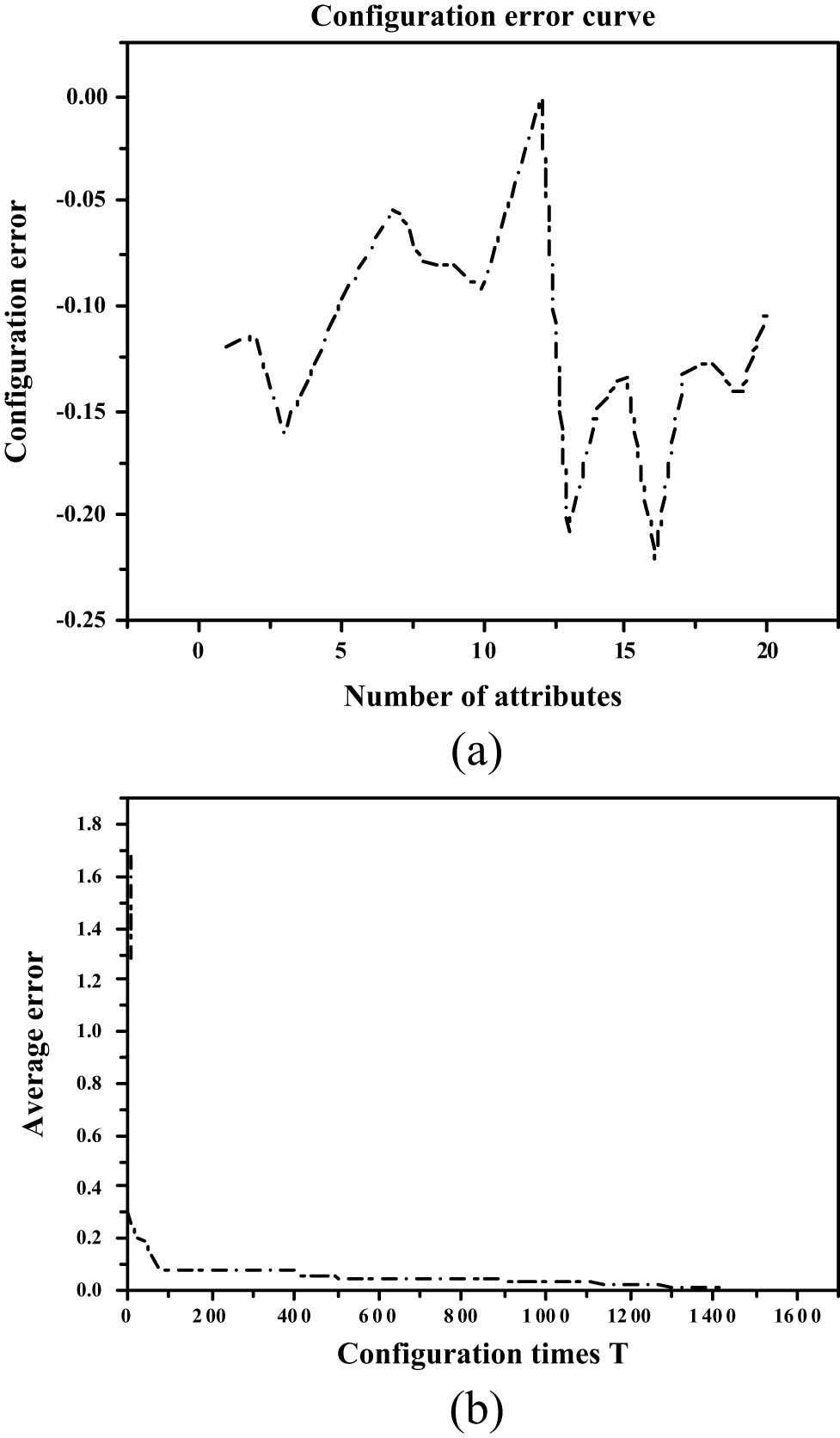
(a) Configuration error, (b) Average error of flexible resource allocation based on hybrid quantum neural network.
4.2.1 Dataset Description
Greenhouse gas emissions from different economic sectors are broken out in this dataset, with each sector’s contribution quantified in terms of CO2 equivalent per dollar spent in 2021. It sheds light on the environmental effect of economic activity across sectors by providing information on direct emissions and those linked to supply chain margins. This dataset (https://www.kaggle.com/datasets/sahirmaharajj/supply-chain-greenhouse-gas-emission) contains a wealth of information that data scientists and environmental researchers may use to analyse the economic activities’ carbon impact. Research into lifespan assessments, sustainability policymaking, and the creation of low-carbon investment plans are all bolstered by this.
4.3 Flexible Resource Allocation Solution based on Multi-Attribute Utility Association
Based on the analysis of a low-carbon supply chain’s flexible resource allocation model, this essay studies some points that should be paid attention to in the actual allocation process from the perspective of flexible resource attributes of a low-carbon supply chain. In this essay, the relevance of resource attribute utility is considered in the configuration process. In the following, the law of resource allocation and the result of allocation are analysed through the association of several low-carbon supply chains’ flexible resource features. The resource allocation is analysed from the perspective of resource attributes, and then the specific analysis is conducted through the experimental results. Figure 16 depicts the flow chart for the flexible resource allocation model’s hybrid quantum neural network algorithm.
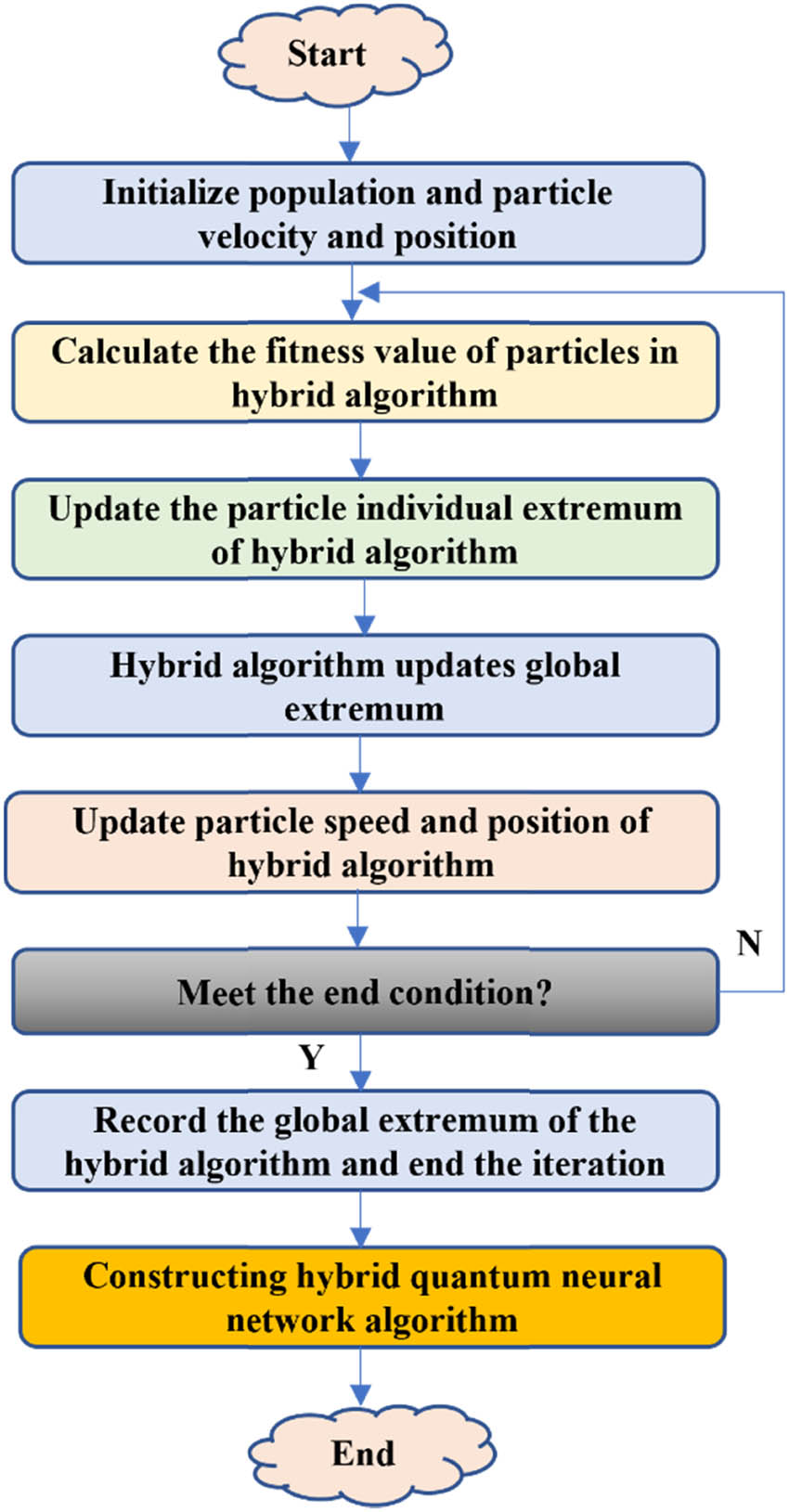
Flow chart for the flexible resource allocation model using a hybrid quantum neural network technique.
Cognitive and behavioural uncertainty are the two categories of uncertainty the theory recognizes. People may learn more about one another using one of three passive, active, or interactive approaches. Neural networks enable computers to make smart judgements with little human intervention. This is due to their remarkable ability to understand and represent intricate, nonlinear input and output data interactions. There are potential problems with your data, such as unknown values, distributions, or sources, as well as missing or incomplete information. Artificial intelligence uses relative frequencies or integrates many statistical models derived from data and information gathered from different sources to quantify uncertainty. Domain specialists may provide some of these indicators, while others are objective.
5 Conclusion
To sum up, the current global economic integration and environmental issues have globalized. Facing the increasingly rapid development of globalization, establishing and implementing the low-carbon sustainable development concept is also necessary for nodal enterprises in the supply chain to meet the development goals of the 13th 5-Year Period. We should not only pursue the maximization of the economic benefit of the low-carbon supply chain but also strive to maximize the environmental benefit of the supply chain, to achieve the balance of economic benefit and environmental benefit of enterprises at each node of the supply chain. The research contents of flexible resource allocation in low-carbon supply chains are all hot and difficult areas. The research in this essay mainly focuses on the configuration model and its hybrid neural network algorithm. Although a lot of simulation experiments are applied to carry out relevant verification in the research process, due to the limitation of time and ability, there are still many deficiencies in this research, which need to be further studied and explored.
The innovative concept of sustainable supply chains is based on the idea that businesses may better serve society and the environment by enhancing the efficiency and effectiveness of their operations via information technology. Among the most important components of smart’s technical backbone in this regard is the IoT. This article focuses on learning how to establish an IoT-based sustainable supply chain. This framework was developed by reviewing the literature, conducting surveys of the general public, and analysing the views of experts in the area, all with an eye toward the IoT’ four-stage design. What follows is derived from the results: a low-carbon policy makes it more likely that merchants and manufacturers would use a centralized decision-making mode to boost supply chain earnings while cutting carbon emissions to the greatest extent possible. Second, although a higher carbon tax rate will lead to greater emission reductions from producers and consumers, it will have the opposite effect on retailers’ order quantities, the supply chain’s overall profit, and businesses’ profitability. Finally, this article’s supply chain coordination contract is fairly structured, which may boost the reduction of carbon emissions across the supply chain and mobilize enterprise-wide enthusiasm for reducing emissions. In the meantime, comprehensive coordination may be achieved by distributing the revenues according to the adjusted coordination contract. As a point, the government should establish fair tax rates and low-carbon subsidy programs to encourage businesses to cut emissions and foster the growth of supply chain businesses in a coordinated and healthy way. In addition to providing a framework for aligning business operations with the United Nations Sustainable Development Goals, they may foster innovation, promote sustainability, and direct strategic decision-making. This information allows lawmakers and corporations to work together for a better, more sustainable future. The disparity in GSCM adoption across regions is multifaceted and complex, necessitating tailored responses from businesses, governments, and sustainability advocates worldwide. Recognizing and effectively addressing these variances is crucial for advancing the global sustainability agenda and ensuring that no area is left behind in transitioning to more sustainable supply chains. Future research and strategy development may be guided by the results, which also support the idea that sustainable behaviours and technology can help create a more sustainable future. Important publications discovered via keyword searches may have been omitted or excluded, and the study may have failed to account for grey literature.
There are several ways to decrease carbon emissions, which is a limitation of this research from a practical standpoint. Retailers may promote low-carbon product sales via in-store promotions and pamphlets, while manufacturers can use new technology, equipment, pollution control systems, and strategies to reduce emissions. One of several such techniques is to consider the effect of customers’ low-carbon desires. Another constraint is that, in practice, the free-rider phenomenon can occur if a single supplier decides to reduce carbon emissions independently. Future studies will undoubtedly involve further effort. In particular, the analysis presupposes that the coefficients for consumer choice, pricing, and market demand are all linearly related. It is important to consider the relationship between market demand and the factors that influence it to make sense of the real market environment, which is affected by things like competition and imbalances in supply and marketing. Additionally, in the real world, the LCSC’s operation and DM include several suppliers, and the game’s decision-makers include governments and customers.
-
Funding information: Chongqing Natural Science Fund, China (Grant No. CSTC2019CYJ-BSHX0026); Scientific and Technological Research Program of Chongqing Municipal Education Commission (Grant No. KJQN202203313); Chongqing Postdoctoral Research Grant Project. Scientific Research Innovation Team building project of Chongqing City Management College (Grant No. KYTD2020005).
-
Author contributions: All authors have accepted responsibility for the entire content of this manuscript and consented to its submission to the journal, reviewed all the results and approved the final version of the manuscript. All authors contributed equally to the development of the Sustainable development of low-carbon supply chain economy based on the IoT and environmental responsibility. ZM: conceptualization, methodology, investigation, and writing (original draft). XY: methodology, data curation, and validation. RM: conceptualization, resources, and project administration. YY: conceptualization, supervision, review, and editing.
-
Conflict of interest: Authors state no conflict of interest.
-
Data availability statement: https://www.kaggle.com/datasets/sahirmaharajj/supply-chain-greenhouse-gas-emission.
-
Article note: As part of the open assessment, reviews and the original submission are available as supplementary files on our website.
References
Aliahmadi, A., Nozari, H., Ghahremani-Nahr, J., & Szmelter-Jarosz, A. (2022). Evaluation of key impression of resilient supply chain based on artificial intelligence of things (AIoT). arXiv preprint arXiv:2207.13174.Search in Google Scholar
Alkawsi, G. A., & Baashar, Y. (2020). An empirical study of the acceptance of iot-based smart meter in malaysia: The effect of electricity-saving knowledge and environmental awareness. IEEE Access, 8, 42794–42804.10.1109/ACCESS.2020.2977060Search in Google Scholar
Andalib Ardakani, D., Kiani, M., Saffari Darberazi, A., Zamzam, F., & Mofatehzadeh, E. (2024). An interval type-2 fuzzy AHP approach for success factors of green supply chain management. International Journal of Research in Industrial Engineering, 13(3), 104–123.Search in Google Scholar
Cheryl, B. K., Ng, B. K., & Wong, C. Y. (2021). Governing the progress of internet-of-things: Ambivalence in the quest of technology exploitation and user rights protection. Technology in Society, 64(2021), 101463.10.1016/j.techsoc.2020.101463Search in Google Scholar
Dhiman, G., Vinoth Kumar, V., Kaur, A., & Sharma, A. (2021). Don: Deep learning and optimization-based framework for detection of novel coronavirus disease using x-ray images. Interdisciplinary Sciences Computational Life Sciences, 13, 260–272.10.1007/s12539-021-00418-7Search in Google Scholar
Ghosh, N., Paul, R., Maity, S., Maity, K., & Saha, S. (2020). Fault matters: Sensor data fusion for detection of faults using dempster-shafer theory of evidence in iot-based applications. Expert Systems with Applications, 162(4), 113887.10.1016/j.eswa.2020.113887Search in Google Scholar
Ghosh, S. K., Seikh, M. R., & Chakrabortty, M. (2020). Analyzing a stochastic dual-channel supply chain under consumers’ low carbon preferences and cap-and-trade regulation. Computers & Industrial Engineering, 149(5), 106765.10.1016/j.cie.2020.106765Search in Google Scholar
Guo, E., Jagota, V., Makhatha, M. & Kumar, P. (2021). Study on fault identification of mechanical dynamic nonlinear transmission system. Nonlinear Engineering, 10(1), 518–525.10.1515/nleng-2021-0042Search in Google Scholar
Huang, R., Zhang, S., Zhang, W., & Yang, X. (2021). Progress of zinc oxide-based nanocomposites in the textile industry, IET Collaborative Intelligent Manufacturing, 3(3), 281–289.10.1049/cim2.12029Search in Google Scholar
Li, J., & Gong, S. (2020). Coordination of closed-loop supply chain with dual-source supply and low-carbon concern. Complexity, 2020(5), 1–14.10.1155/2020/7506791Search in Google Scholar
Lin, J., Fan, R., Tan, X., & Zhu, K. (2021). Dynamic decision and coordination in a low-carbon supply chain considering the retailer’s social preference. Socio-Economic Planning Sciences, 11, 101010.10.1016/j.seps.2021.101010Search in Google Scholar
Liu, J., Liu, X., Chen, J., Li, X., Ma, T., & Zhong, F. (2021). Investigation of ZrMnFe/sepiolite catalysts on toluene deg-radation in a one-stage plasma-catalysis system. Catalysts, 11, 828.10.3390/catal11070828Search in Google Scholar
Liu, Z., Hu, B., Huang, B., Lang, L., & Zhao, Y. (2020). Decision optimization of low-carbon dual-channel supply chain of auto parts based on smart city architecture. Complexity, 2020(5), 1–14.10.1155/2020/2145951Search in Google Scholar
Mansory, A., Nasiri, A., & Mohammadi, N. (2021). Proposing an integrated model for evaluation of green and resilient suppliers by path analysis, SWARA and TOPSIS. Journal of Applied Research on Industrial Engineering, 8(2), 129–149.Search in Google Scholar
Meng, H., Ju, Z., & Huang, Y. (2021). Analysis of energy supply chain in steel industry self-provided power plant. Journal of Physics: Conference Series, 1910(1), 012024 (7pp).10.1088/1742-6596/1910/1/012024Search in Google Scholar
Mozaffari, M. R., & Ostovan, S. (2021). Finding projection in the two-stage supply chain in DEA-R with random data using (CRA) model. Big Data and Computing Visions, 1(3), 146–155.Search in Google Scholar
Peng, Q., Wang, C., & Xu, L. (2020). Emission abatement and procurement strategies in a low-carbon supply chain with option contracts under stochastic demand. Computers & Industrial Engineering, 144(2), 106502.10.1016/j.cie.2020.106502Search in Google Scholar
Wang, Y., Yu, Z., Jin, M., & Mao, J. (2021). Decisions and coordination of retailer-led low-carbon supply chain under altruistic preference. European Journal of Operational Research, 293(3), 910–925.10.1016/j.ejor.2020.12.060Search in Google Scholar
Xi, X., & Zhang, Y. (2022). Complexity analysis of pricing, service level, and emission reduction effort in an e-commerce supply chain under different power structures. International Journal of Bifurcation and Chaos, 32(2), 2250023.10.1142/S0218127422500237Search in Google Scholar
Xia, X., Li, C., & Zhu, Q. (2020). Game analysis for the impact of carbon trading on low-carbon supply chain. Journal of Cleaner Production, 276(3), 123220.10.1016/j.jclepro.2020.123220Search in Google Scholar
Zhang, G., Cheng, P., Sun, H., Shi, Y., & Kadiane, A. (2021). Carbon reduction decisions under progressive carbon tax regulations: A new dual-channel supply chain network equilibrium model. Sustainable Production and Consumption, 27(1), 1077–1092.10.1016/j.spc.2021.02.029Search in Google Scholar
Zhang, Y., & Zhang, T. (2022). Complex dynamics of a low-carbon supply chain with government green subsidies and carbon cap-and-trade policies. International Journal of Bifurcation and Chaos, 32(6), 2250090.10.1142/S0218127422500900Search in Google Scholar
Zhu, X., Chiong, R., Wang, M., Liu, K., & Ren, M. (2021). Is carbon regulation better than cash subsidy? the case of new energy vehicles. Transportation Research Part a Policy and Practice, 146(4), 170–192.10.1016/j.tra.2021.01.018Search in Google Scholar
© 2024 the author(s), published by De Gruyter
This work is licensed under the Creative Commons Attribution 4.0 International License.
Articles in the same Issue
- Regular Articles
- Political Turnover and Public Health Provision in Brazilian Municipalities
- Examining the Effects of Trade Liberalisation Using a Gravity Model Approach
- Operating Efficiency in the Capital-Intensive Semiconductor Industry: A Nonparametric Frontier Approach
- Does Health Insurance Boost Subjective Well-being? Examining the Link in China through a National Survey
- An Intelligent Approach for Predicting Stock Market Movements in Emerging Markets Using Optimized Technical Indicators and Neural Networks
- Analysis of the Effect of Digital Financial Inclusion in Promoting Inclusive Growth: Mechanism and Statistical Verification
- Effective Tax Rates and Firm Size under Turnover Tax: Evidence from a Natural Experiment on SMEs
- Re-investigating the Impact of Economic Growth, Energy Consumption, Financial Development, Institutional Quality, and Globalization on Environmental Degradation in OECD Countries
- A Compliance Return Method to Evaluate Different Approaches to Implementing Regulations: The Example of Food Hygiene Standards
- Panel Technical Efficiency of Korean Companies in the Energy Sector based on Digital Capabilities
- Time-varying Investment Dynamics in the USA
- Preferences, Institutions, and Policy Makers: The Case of the New Institutionalization of Science, Technology, and Innovation Governance in Colombia
- The Impact of Geographic Factors on Credit Risk: A Study of Chinese Commercial Banks
- The Heterogeneous Effect and Transmission Paths of Air Pollution on Housing Prices: Evidence from 30 Large- and Medium-Sized Cities in China
- Analysis of Demographic Variables Affecting Digital Citizenship in Turkey
- Green Finance, Environmental Regulations, and Green Technologies in China: Implications for Achieving Green Economic Recovery
- Coupled and Coordinated Development of Economic Growth and Green Sustainability in a Manufacturing Enterprise under the Context of Dual Carbon Goals: Carbon Peaking and Carbon Neutrality
- Revealing the New Nexus in Urban Unemployment Dynamics: The Relationship between Institutional Variables and Long-Term Unemployment in Colombia
- The Roles of the Terms of Trade and the Real Exchange Rate in the Current Account Balance
- Cleaner Production: Analysis of the Role and Path of Green Finance in Controlling Agricultural Nonpoint Source Pollution
- The Research on the Impact of Regional Trade Network Relationships on Value Chain Resilience in China’s Service Industry
- Social Support and Suicidal Ideation among Children of Cross-Border Married Couples
- Asymmetrical Monetary Relations and Involuntary Unemployment in a General Equilibrium Model
- Job Crafting among Airport Security: The Role of Organizational Support, Work Engagement and Social Courage
- Does the Adjustment of Industrial Structure Restrain the Income Gap between Urban and Rural Areas
- Optimizing Emergency Logistics Centre Locations: A Multi-Objective Robust Model
- Geopolitical Risks and Stock Market Volatility in the SAARC Region
- Trade Globalization, Overseas Investment, and Tax Revenue Growth in Sub-Saharan Africa
- Can Government Expenditure Improve the Efficiency of Institutional Elderly-Care Service? – Take Wuhan as an Example
- Media Tone and Earnings Management before the Earnings Announcement: Evidence from China
- Review Articles
- Economic Growth in the Age of Ubiquitous Threats: How Global Risks are Reshaping Growth Theory
- Efficiency Measurement in Healthcare: The Foundations, Variables, and Models – A Narrative Literature Review
- Rethinking the Theoretical Foundation of Economics I: The Multilevel Paradigm
- Financial Literacy as Part of Empowerment Education for Later Life: A Spectrum of Perspectives, Challenges and Implications for Individuals, Educators and Policymakers in the Modern Digital Economy
- Special Issue: Economic Implications of Management and Entrepreneurship - Part II
- Ethnic Entrepreneurship: A Qualitative Study on Entrepreneurial Tendency of Meskhetian Turks Living in the USA in the Context of the Interactive Model
- Bridging Brand Parity with Insights Regarding Consumer Behavior
- The Effect of Green Human Resources Management Practices on Corporate Sustainability from the Perspective of Employees
- Special Issue: Shapes of Performance Evaluation in Economics and Management Decision - Part II
- High-Quality Development of Sports Competition Performance Industry in Chengdu-Chongqing Region Based on Performance Evaluation Theory
- Analysis of Multi-Factor Dynamic Coupling and Government Intervention Level for Urbanization in China: Evidence from the Yangtze River Economic Belt
- The Impact of Environmental Regulation on Technological Innovation of Enterprises: Based on Empirical Evidences of the Implementation of Pollution Charges in China
- Environmental Social Responsibility, Local Environmental Protection Strategy, and Corporate Financial Performance – Empirical Evidence from Heavy Pollution Industry
- The Relationship Between Stock Performance and Money Supply Based on VAR Model in the Context of E-commerce
- A Novel Approach for the Assessment of Logistics Performance Index of EU Countries
- The Decision Behaviour Evaluation of Interrelationships among Personality, Transformational Leadership, Leadership Self-Efficacy, and Commitment for E-Commerce Administrative Managers
- Role of Cultural Factors on Entrepreneurship Across the Diverse Economic Stages: Insights from GEM and GLOBE Data
- Performance Evaluation of Economic Relocation Effect for Environmental Non-Governmental Organizations: Evidence from China
- Functional Analysis of English Carriers and Related Resources of Cultural Communication in Internet Media
- The Influences of Multi-Level Environmental Regulations on Firm Performance in China
- Exploring the Ethnic Cultural Integration Path of Immigrant Communities Based on Ethnic Inter-Embedding
- Analysis of a New Model of Economic Growth in Renewable Energy for Green Computing
- An Empirical Examination of Aging’s Ramifications on Large-scale Agriculture: China’s Perspective
- The Impact of Firm Digital Transformation on Environmental, Social, and Governance Performance: Evidence from China
- Accounting Comparability and Labor Productivity: Evidence from China’s A-Share Listed Firms
- An Empirical Study on the Impact of Tariff Reduction on China’s Textile Industry under the Background of RCEP
- Top Executives’ Overseas Background on Corporate Green Innovation Output: The Mediating Role of Risk Preference
- Neutrosophic Inventory Management: A Cost-Effective Approach
- Mechanism Analysis and Response of Digital Financial Inclusion to Labor Economy based on ANN and Contribution Analysis
- Asset Pricing and Portfolio Investment Management Using Machine Learning: Research Trend Analysis Using Scientometrics
- User-centric Smart City Services for People with Disabilities and the Elderly: A UN SDG Framework Approach
- Research on the Problems and Institutional Optimization Strategies of Rural Collective Economic Organization Governance
- The Impact of the Global Minimum Tax Reform on China and Its Countermeasures
- Sustainable Development of Low-Carbon Supply Chain Economy based on the Internet of Things and Environmental Responsibility
- Measurement of Higher Education Competitiveness Level and Regional Disparities in China from the Perspective of Sustainable Development
- Payment Clearing and Regional Economy Development Based on Panel Data of Sichuan Province
- Coordinated Regional Economic Development: A Study of the Relationship Between Regional Policies and Business Performance
- A Novel Perspective on Prioritizing Investment Projects under Future Uncertainty: Integrating Robustness Analysis with the Net Present Value Model
- Research on Measurement of Manufacturing Industry Chain Resilience Based on Index Contribution Model Driven by Digital Economy
- Special Issue: AEEFI 2023
- Portfolio Allocation, Risk Aversion, and Digital Literacy Among the European Elderly
- Exploring the Heterogeneous Impact of Trade Agreements on Trade: Depth Matters
- Import, Productivity, and Export Performances
- Government Expenditure, Education, and Productivity in the European Union: Effects on Economic Growth
- Replication Study
- Carbon Taxes and CO2 Emissions: A Replication of Andersson (American Economic Journal: Economic Policy, 2019)
Articles in the same Issue
- Regular Articles
- Political Turnover and Public Health Provision in Brazilian Municipalities
- Examining the Effects of Trade Liberalisation Using a Gravity Model Approach
- Operating Efficiency in the Capital-Intensive Semiconductor Industry: A Nonparametric Frontier Approach
- Does Health Insurance Boost Subjective Well-being? Examining the Link in China through a National Survey
- An Intelligent Approach for Predicting Stock Market Movements in Emerging Markets Using Optimized Technical Indicators and Neural Networks
- Analysis of the Effect of Digital Financial Inclusion in Promoting Inclusive Growth: Mechanism and Statistical Verification
- Effective Tax Rates and Firm Size under Turnover Tax: Evidence from a Natural Experiment on SMEs
- Re-investigating the Impact of Economic Growth, Energy Consumption, Financial Development, Institutional Quality, and Globalization on Environmental Degradation in OECD Countries
- A Compliance Return Method to Evaluate Different Approaches to Implementing Regulations: The Example of Food Hygiene Standards
- Panel Technical Efficiency of Korean Companies in the Energy Sector based on Digital Capabilities
- Time-varying Investment Dynamics in the USA
- Preferences, Institutions, and Policy Makers: The Case of the New Institutionalization of Science, Technology, and Innovation Governance in Colombia
- The Impact of Geographic Factors on Credit Risk: A Study of Chinese Commercial Banks
- The Heterogeneous Effect and Transmission Paths of Air Pollution on Housing Prices: Evidence from 30 Large- and Medium-Sized Cities in China
- Analysis of Demographic Variables Affecting Digital Citizenship in Turkey
- Green Finance, Environmental Regulations, and Green Technologies in China: Implications for Achieving Green Economic Recovery
- Coupled and Coordinated Development of Economic Growth and Green Sustainability in a Manufacturing Enterprise under the Context of Dual Carbon Goals: Carbon Peaking and Carbon Neutrality
- Revealing the New Nexus in Urban Unemployment Dynamics: The Relationship between Institutional Variables and Long-Term Unemployment in Colombia
- The Roles of the Terms of Trade and the Real Exchange Rate in the Current Account Balance
- Cleaner Production: Analysis of the Role and Path of Green Finance in Controlling Agricultural Nonpoint Source Pollution
- The Research on the Impact of Regional Trade Network Relationships on Value Chain Resilience in China’s Service Industry
- Social Support and Suicidal Ideation among Children of Cross-Border Married Couples
- Asymmetrical Monetary Relations and Involuntary Unemployment in a General Equilibrium Model
- Job Crafting among Airport Security: The Role of Organizational Support, Work Engagement and Social Courage
- Does the Adjustment of Industrial Structure Restrain the Income Gap between Urban and Rural Areas
- Optimizing Emergency Logistics Centre Locations: A Multi-Objective Robust Model
- Geopolitical Risks and Stock Market Volatility in the SAARC Region
- Trade Globalization, Overseas Investment, and Tax Revenue Growth in Sub-Saharan Africa
- Can Government Expenditure Improve the Efficiency of Institutional Elderly-Care Service? – Take Wuhan as an Example
- Media Tone and Earnings Management before the Earnings Announcement: Evidence from China
- Review Articles
- Economic Growth in the Age of Ubiquitous Threats: How Global Risks are Reshaping Growth Theory
- Efficiency Measurement in Healthcare: The Foundations, Variables, and Models – A Narrative Literature Review
- Rethinking the Theoretical Foundation of Economics I: The Multilevel Paradigm
- Financial Literacy as Part of Empowerment Education for Later Life: A Spectrum of Perspectives, Challenges and Implications for Individuals, Educators and Policymakers in the Modern Digital Economy
- Special Issue: Economic Implications of Management and Entrepreneurship - Part II
- Ethnic Entrepreneurship: A Qualitative Study on Entrepreneurial Tendency of Meskhetian Turks Living in the USA in the Context of the Interactive Model
- Bridging Brand Parity with Insights Regarding Consumer Behavior
- The Effect of Green Human Resources Management Practices on Corporate Sustainability from the Perspective of Employees
- Special Issue: Shapes of Performance Evaluation in Economics and Management Decision - Part II
- High-Quality Development of Sports Competition Performance Industry in Chengdu-Chongqing Region Based on Performance Evaluation Theory
- Analysis of Multi-Factor Dynamic Coupling and Government Intervention Level for Urbanization in China: Evidence from the Yangtze River Economic Belt
- The Impact of Environmental Regulation on Technological Innovation of Enterprises: Based on Empirical Evidences of the Implementation of Pollution Charges in China
- Environmental Social Responsibility, Local Environmental Protection Strategy, and Corporate Financial Performance – Empirical Evidence from Heavy Pollution Industry
- The Relationship Between Stock Performance and Money Supply Based on VAR Model in the Context of E-commerce
- A Novel Approach for the Assessment of Logistics Performance Index of EU Countries
- The Decision Behaviour Evaluation of Interrelationships among Personality, Transformational Leadership, Leadership Self-Efficacy, and Commitment for E-Commerce Administrative Managers
- Role of Cultural Factors on Entrepreneurship Across the Diverse Economic Stages: Insights from GEM and GLOBE Data
- Performance Evaluation of Economic Relocation Effect for Environmental Non-Governmental Organizations: Evidence from China
- Functional Analysis of English Carriers and Related Resources of Cultural Communication in Internet Media
- The Influences of Multi-Level Environmental Regulations on Firm Performance in China
- Exploring the Ethnic Cultural Integration Path of Immigrant Communities Based on Ethnic Inter-Embedding
- Analysis of a New Model of Economic Growth in Renewable Energy for Green Computing
- An Empirical Examination of Aging’s Ramifications on Large-scale Agriculture: China’s Perspective
- The Impact of Firm Digital Transformation on Environmental, Social, and Governance Performance: Evidence from China
- Accounting Comparability and Labor Productivity: Evidence from China’s A-Share Listed Firms
- An Empirical Study on the Impact of Tariff Reduction on China’s Textile Industry under the Background of RCEP
- Top Executives’ Overseas Background on Corporate Green Innovation Output: The Mediating Role of Risk Preference
- Neutrosophic Inventory Management: A Cost-Effective Approach
- Mechanism Analysis and Response of Digital Financial Inclusion to Labor Economy based on ANN and Contribution Analysis
- Asset Pricing and Portfolio Investment Management Using Machine Learning: Research Trend Analysis Using Scientometrics
- User-centric Smart City Services for People with Disabilities and the Elderly: A UN SDG Framework Approach
- Research on the Problems and Institutional Optimization Strategies of Rural Collective Economic Organization Governance
- The Impact of the Global Minimum Tax Reform on China and Its Countermeasures
- Sustainable Development of Low-Carbon Supply Chain Economy based on the Internet of Things and Environmental Responsibility
- Measurement of Higher Education Competitiveness Level and Regional Disparities in China from the Perspective of Sustainable Development
- Payment Clearing and Regional Economy Development Based on Panel Data of Sichuan Province
- Coordinated Regional Economic Development: A Study of the Relationship Between Regional Policies and Business Performance
- A Novel Perspective on Prioritizing Investment Projects under Future Uncertainty: Integrating Robustness Analysis with the Net Present Value Model
- Research on Measurement of Manufacturing Industry Chain Resilience Based on Index Contribution Model Driven by Digital Economy
- Special Issue: AEEFI 2023
- Portfolio Allocation, Risk Aversion, and Digital Literacy Among the European Elderly
- Exploring the Heterogeneous Impact of Trade Agreements on Trade: Depth Matters
- Import, Productivity, and Export Performances
- Government Expenditure, Education, and Productivity in the European Union: Effects on Economic Growth
- Replication Study
- Carbon Taxes and CO2 Emissions: A Replication of Andersson (American Economic Journal: Economic Policy, 2019)

